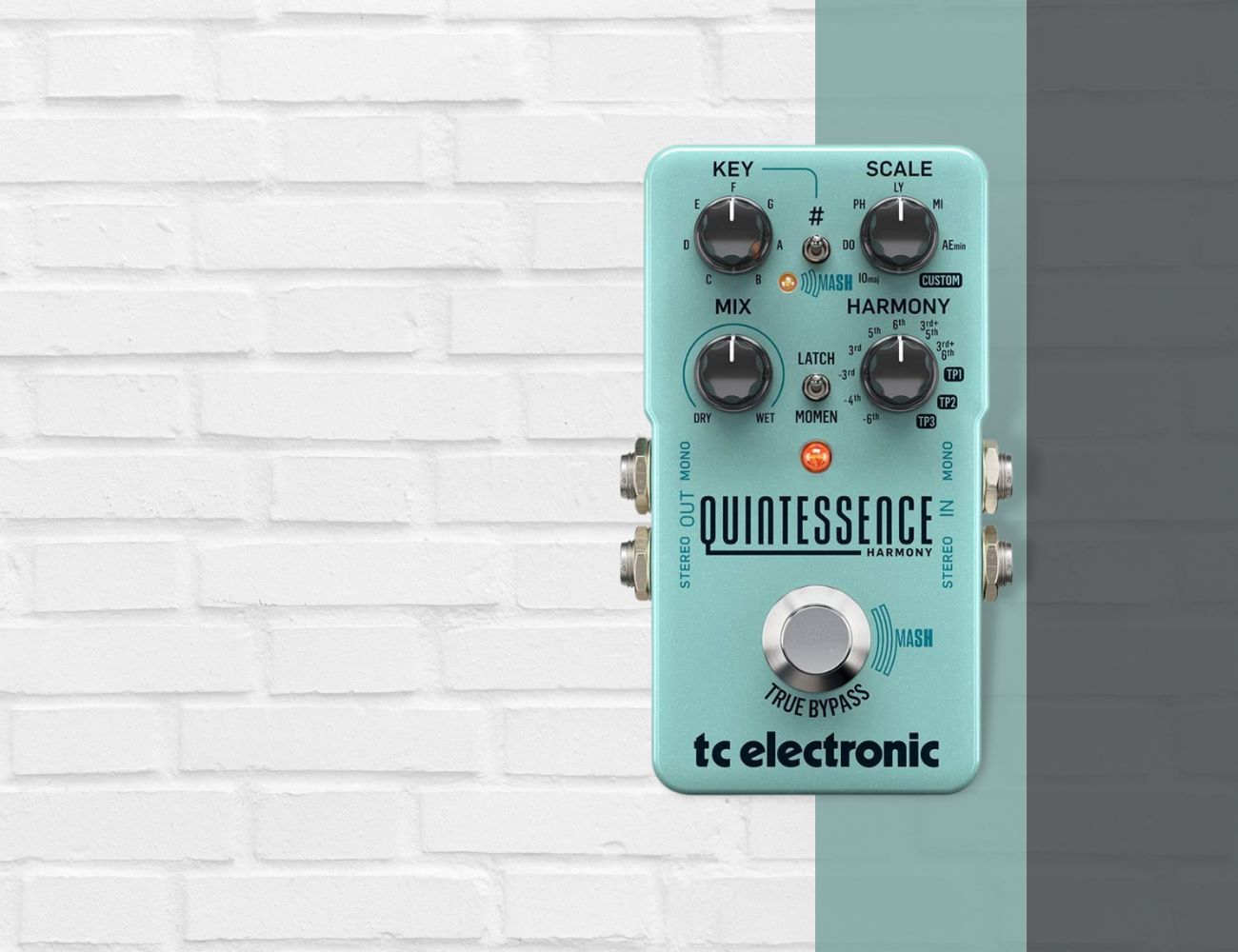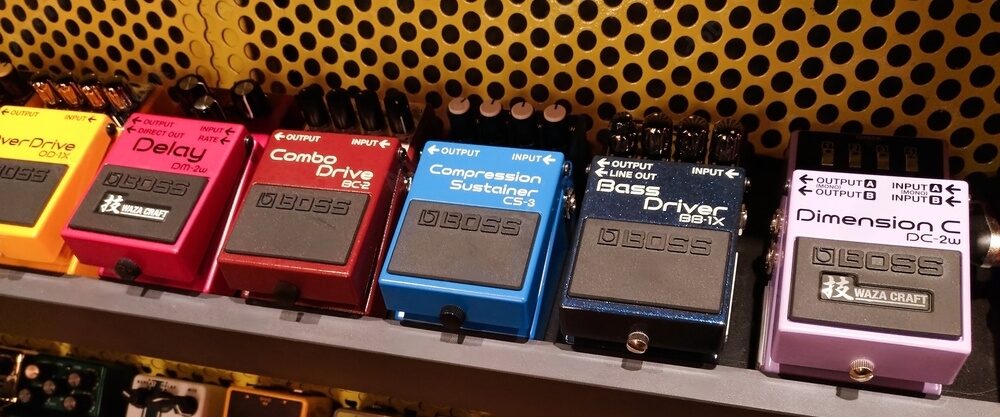Every guitarist knows that in some cases, the secret to achieving that lush, complex sound is to have a killer harmonizer pedal.
But with so many options, how do you even begin to choose?
I’ve got your back, bringing you an in-depth review of the top picks and a breakdown of what sets them apart, with pros, cons, and my honest take.
From brands to budget-unique features to user-friendliness, we’ll delve into everything you need to know to make a perfect choice.
Aside from that, I’ll also answer some frequently asked questions on this topic so that you can have a better idea of what to expect when buying a new harmonizer pedal.
Table of Contents
- Best Harmonizer Pedals
- Eventide H9 Max Harmonizer Pedal
- TC Electronic Quintessence Harmonizer Pedal
- MOOER Pitch Box Guitar Harmonizer Pedal
- EarthQuaker Devices Organizer Organ Emulator Pedal
- Stax Guitar Harmonizer Pedal
- MOOER Pure Octave Precise Pedal
- Pulse PT-37 Harmonizer Pitch Shifter Pedal
- Eventide PitchFactor Harmonizer Pitch Pedal
- Rowin Harmonizer Digital Guitar Effect Pedal
- Digitech Mini Pitch Acoustic Guitar Effect Pedal
- Boss PS-6 Harmonizer Guitar Effects Pedal
- EarthQuaker Devices Rainbow Machine Pitch-Shifting Modulator Pedal
- Boss VE-2 Vocal Harmonist Effects Processor Pedal
- Donner Octave Guitar Pedal
- EarthQuaker Devices Data Corrupter Harmonizing Pedal
- TC Electronic BRAINWAVES Pitch Shifter Harmonizer Pedal
- Beetronics Swarm Fuzz Harmonizer Pedal
- What exactly is a harmonizer pedal?
- What should you consider when choosing a harmonizer pedal?
- How to properly use a harmonizer pedal?
- How to order pedals on a pedalboard?
- Boutique vs. Mass-Produced pedals
- How much should you spend on a guitar pedal?
- Can you use a guitar pedal with a bass guitar?
- How to properly power your pedals?
Best Harmonizer Pedals
Before I begin, here are my top selected choices:
TC Electronic Quintessence Harmonizer Pedal

MASH technology, TonePrint editing, customizable harmonies, no-loss tone. Check Price
|
|
Stax Guitar Harmonizer Pedal

High-sensitivity, polyphonic pitch shifting pedal with ±2 Oct range. Check Price
|
Eventide H9 Max Harmonizer Pedal
Provides comprehensive sound shaping with 45 algorithms and 600+ presets.
The Eventide H9 Harmonizer Effects Processor offers an extensive range of algorithms and effects from the company’s acclaimed pedals, plus exclusive algorithms and Bluetooth control via its free app. It also features a built-in expression pedal for parameter control.
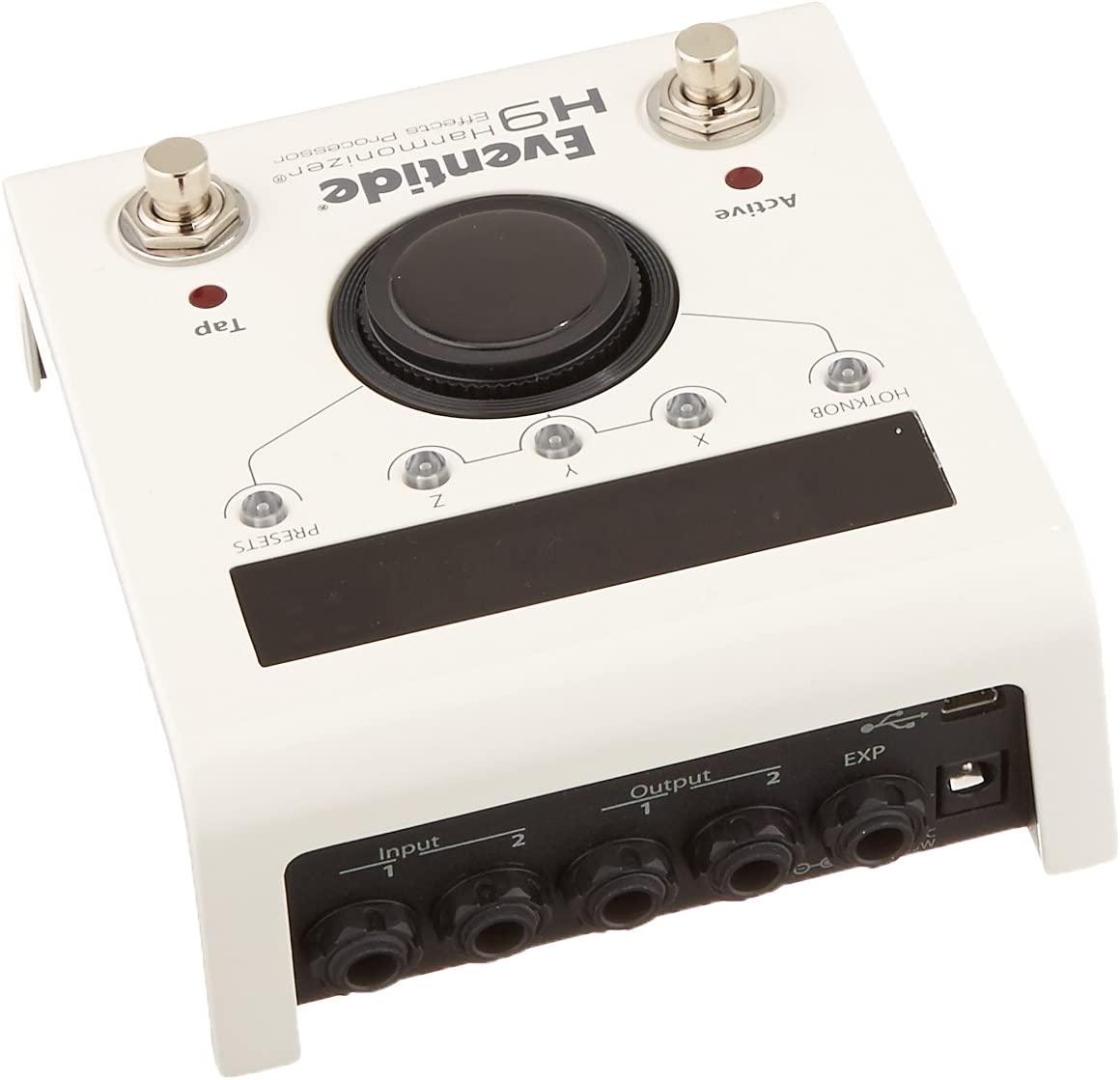
Tucked into a compact, white package, the Eventide H9 Max Harmonizer Pedal is versatile.
A highlight is its wide array of algorithms – 45, taken from Eventide’s popular stompboxes: Space, Time Factor, Pitch Factor, and Mod Factor.
It also boasts unique features only found in the H9, like Ultra Tap delay, Resonator, and Compressor EQ, among others.
With over 600 factory presets (99 pre-installed, the rest accessible via the H9 Control App), it allows for considerable sonic exploration.
While compact, measuring 10.5 x 6.5 x 3 inches and weighing in at 2.5 pounds, it’s a tool that offers massive functionality.
It can share algorithms with up to four other H9 units; it includes a built-in tuner, true bypass, and MIDI compatibility, and it’s wirelessly controllable via Bluetooth using the H9 Control app on Windows, OSX, or iOS devices.
So, it’s not just a pedal – it’s a toolkit of sounds at your feet.
- My Review
Having spent time with the Eventide H9 Max Harmonizer Pedal, it’s clear this device isn’t a typical guitar pedal.
Its range of sounds is expansive, from the lushest reverb to the grittiest distortion, with everything in between.
Each of its 45 algorithms opens up a new universe of tones, making this pedal a purchase and an investment into limitless sonic exploration.
Despite its small footprint, the H9 packs a punch.
It fits snugly into any pedalboard, but what it brings to the table is much bigger than its size suggests.
More than once, I’ve found myself lost in its immersive sounds, with hours disappearing as I delved into its range of options.
Navigating its interface, though, is where the waters get a little murky.
There’s a definite learning curve here.
But as daunting as it may initially seem, patience does pay off.
Once you get the hang of it, manipulating the algorithms and parameters becomes second nature, even inspiring.
A standout feature is the H9 Control app.
While controlling a pedal wirelessly may not be everyone’s cup of tea, I found it innovative and surprisingly intuitive.
Tweaking settings on my phone, then hearing the results instantaneously was an unexpectedly refreshing experience.
The app allows for more precise control and easier access to additional presets, effectively putting a world of sounds at your fingertips.
However, the cost of the H9 Max could be a stumbling block for some.
It’s not a budget-friendly pedal, but considering its vast capabilities and quality of sounds, it’s worth every penny.
Here are the ratings I’ll give to the Eventide H9 Max Harmonizer Pedal:
The Eventide H9 Max Harmonizer Pedal is like a Swiss Army knife of the pedal world.
Its broad array of high-quality effects and unique features make it a versatile and exciting tool for any guitarist seeking to expand their sonic boundaries.
- Pros:
- Wide variety of effects.
- Excellent time-based FX.
- High-quality tones and presets.
- Wireless control via Bluetooth.
- Cons:
- Limited on-board controls.
- Some effects may sound digital.
- Issues with the H9 Control app.
My final verdict is that the Eventide H9 Max Harmonizer Pedal is a highly versatile and feature-rich pedal that offers a wide range of effects and high-quality tones.
It excels in time-based effects and provides wireless control through Bluetooth.
However, the limited onboard controls and potential issues with the H9 Control app may be drawbacks.
It is a solid choice for musicians looking for diverse effects in a compact pedal format.
TC Electronic Quintessence Harmonizer Pedal
MASH technology, TonePrint editing, customizable harmonies, no-loss tone.
QUINTESSENCE HARMONY offers a ground-breaking intuitive dual-voiced intelligent harmonizer with MASH footswitch, custom scale modes, and TonePrint technology for expressive harmonies and custom edits. Its MASH feature allows for bends without having to move a finger, while the TonePrint platform allows for 3 personalized slots for custom scales and intervals.
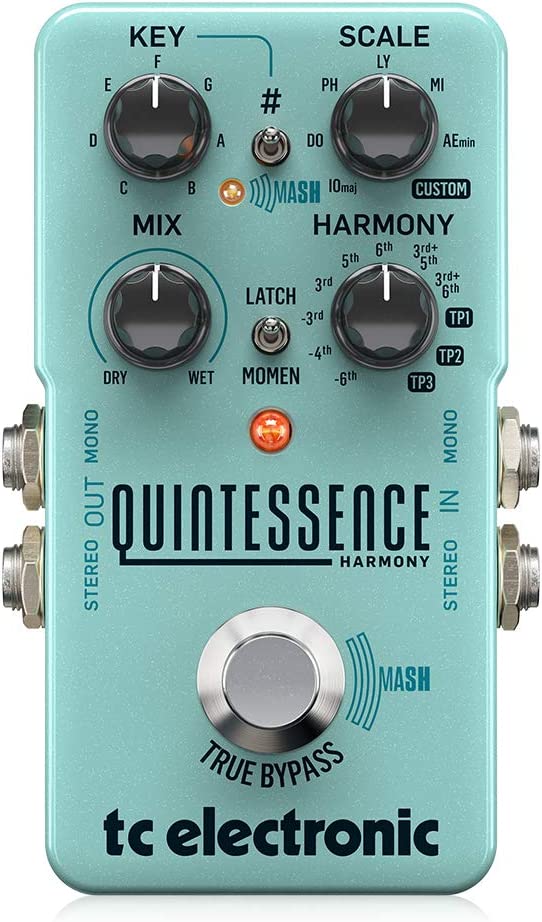
Get ready to tweak your sound with the TC Electronic Quintessence Harmonizer Pedal.
This guitar gadget is an intelligent harmony machine meticulously crafted to provide a tonal landscape filled with lush dual-voiced harmonies.
It can provide anything from third and fifth intervals to more complex sounds in seconds.
It boasts MASH technology which takes your expressive potential to the next level.
MASH footswitch offers real-time expressive control, turning your foot’s pressure into a modulating force.
This way, you can shape your sound in a multitude of ways.
Then, we have the TonePrint Editor. This feature is where the magic truly happens.
It gives you complete control over important parameters, making it your custom unit. Now, that’s flexibility!
Lastly, the pedal’s stereo inputs and outputs are worth mentioning.
Quintessence covers whether you’re running a mono or a full stereo setup.
This unit is more than a harmonizer; it’s a creative tool to take your musical journey to the next level.
- My Review
Having spent quality time with the TC Electronic Quintessence Harmonizer Pedal, I’ve got some insights to share.
Right off the bat, I was amazed by the lushness and variety of the harmonies it could produce.
Do you want a third? You got it.
Fancy a fifth? It’s there in an instant.
It’s like having a backup vocalist ready to harmonize at your command.
Then there’s the MASH technology. This blew me away.
It’s one thing to tweak settings, but to modulate the sound in real-time with foot pressure? That’s quite the game-changer.
I found it offered a level of control that was both intuitive and incredibly satisfying, shaping my sound with a level of nuance I hadn’t expected.
Let’s not forget about the TonePrint Editor.
I’ve played around with many different pieces of gear in my time, but few give the level of customization that this does.
I could tweak parameters to my heart’s content, turning the Quintessence into my harmony pedal.
This is a dream come true for those who like to dive deep into their gear.
Now, no product is perfect, and the Quintessence is no exception.
While it excels in providing complex harmonies, it may require a bit of a learning curve for beginners or those not used to such detailed controls.
Also, it might seem a bit pricey to some, but considering the rich features and customization options, I see it as a worthy investment.
Finally, I appreciated the stereo input and output functionality.
It’s a small detail but crucial for those running in a full stereo setup.
Here are the ratings I’ll give to the TC Electronic Quintessence Harmonizer Pedal:
After my time with the Quintessence, I can confidently say it is more than just a harmonizer pedal.
It’s a versatile tool that offers endless creative possibilities for anyone willing to explore.
- Pros:
- Tracks harmonized notes tightly.
- Intuitive and straightforward design.
- Customizable harmonies with TonePrint editor.
- Solid build quality.
- Capable of creating rich and epic tones.
- Cons:
- Requires musical knowledge and theory.
- Chording sounds less desirable.
- Learning curve for programming and customization.
- Some users experienced tracking issues.
- May not work well on acoustic-electric guitars.
My final verdict is that the TC Electronic Quintessence Harmonizer is a feature-rich pedal with impressive tracking capabilities and solid build quality.
It offers a wide range of harmonization options and intuitive controls.
While it may require some musical knowledge and practice to utilize its potential fully, it can deliver beautiful and epic harmonized tones.
However, there have been reports of occasional tracking issues, and the pedal’s performance may vary for different users.
Considering its brand reputation and value for the price, it is a recommended choice for guitarists seeking to enhance their playing with intelligent harmonization effects.
MOOER Pitch Box Guitar Harmonizer Pedal
Small, exquisite, and versatile pitch shifting with true bypass.
The MOOER Pitch Box is a professional pitch shifter and detune pedal providing 16 different parameters to create a variety of harmony and detune effects. Its true bypass design gives it a transparent sound and a compact size that allows it to fit into most pedal boards. With its intuitive control layout and easy accessibility, the Pitch Box is the perfect solution for any player looking for a pitch shifting and detune pedal that delivers quality sound.
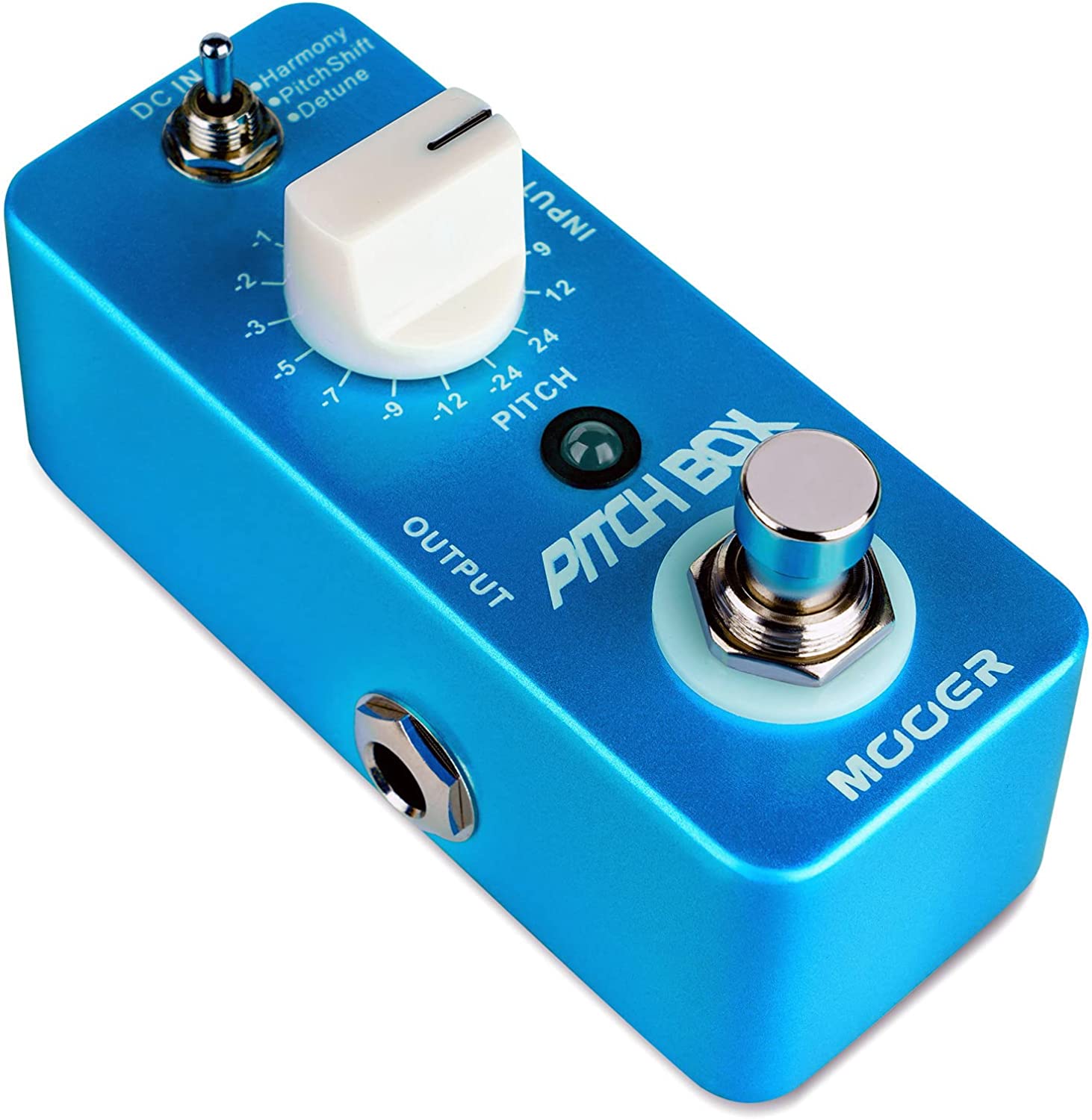
Dive into a world of enhanced sound quality with the CAMOLA MOOER Pitch Box, a compact, harmonious pitch shifter pedal designed especially for electric guitar and bass players.
This pedal’s strength lies in its three distinct effects modes: Harmony, Pitch Shift, and Detune.
The precision of the polyphonic pitch shifting stands out with a flexible pitch range of ±2 octaves, offering 16 adjustable parameters for creating a variety of tones.
Don’t be fooled by its petite size; this pedal packs a punch and sports a robust full metal shell.
It operates on a 9V DC power source (not included) that plugs into the center minus the plug.
You’ll appreciate the true bypass switch that ensures no loss of tone when the pedal is off.
Sporting a minimalist, sleek design, it weighs just 170 grams.
Remember, it’s not just a pedal; it’s your pathway to a more expressive musical experience.
- My Review
Having put the CAMOLA MOOER Pitch Box to the test, I’ve learned its virtues and shortcomings.
Weighing just 170 grams, its compact size belies the powerful performance it delivers.
Slipping comfortably onto my board, this unassuming piece had a fascinating range of effects, each opening up fresh avenues of sonic exploration.
The harmony, pitch shift, and detune modes primarily provided a broad palette, each with unique allure.
Among these, the detune function resonated with me, casting a richer, doubled texture to my sound – a layer of depth that I found quite appealing.
The polyphonic pitch shifting was precise, but what stole the show was the versatility of the ±2 Oct Pitch range.
With 16 tweakable parameters, my fingertips were brimming with possibilities.
It’s important to mention that tuning down drastically could yield a slightly wavering pitch, and pitch shifting beyond a step or two did introduce some noticeable artifacts.
On the downside, it’s noteworthy that the pedal doesn’t come with its power source, which can be a slight inconvenience.
Moreover, there’s a subtle hiss when the pedal is engaged.
It isn’t a major deterrent but can be mildly noticeable depending on the quietness of your setup.
On balance, I appreciated the true bypass feature, maintaining my original tone even when the pedal was turned off.
Given its affordability and potential to enrich your sound, the MOOER Pitch Box offers value that’s hard to beat.
Here are the ratings I’ll give to the MOOER Pitch Box Guitar Harmonizer Pedal:
It’s a robust and reliable companion, although not without its quirks.
It might not be perfect, but it’s a worthwhile addition to your musical toolkit.
- Pros:
- Small and compact design.
- Good sound and tracking.
- Versatile with multiple effects modes.
- Precise polyphonic pitch shifting.
- Value for money.
- Cons:
- No power source included.
- Slight hiss when engaged.
- Some latency and digital artifacts.
- Pitch warble at extreme intervals.
- May not work well with chords.
My final verdict is that the MOOER Pitch Box Guitar Harmonizer Pedal offers a compact and versatile solution for adding depth, harmonies, and pitch-shifting effects to your guitar or bass playing.
It provides sound quality, precise polyphonic pitch shifting, and multiple effects modes.
However, there are concerns regarding the lack of a power source, slight hiss when engaged, potential latency and digital artifacts, and issues with extreme intervals and chord compatibility.
Additionally, there have been reports of quality control issues and reliability problems with the foot switch.
Despite these drawbacks, the pedal offers value for money and can deliver the desired EVH 90s tone.
Ultimately, it is suitable for those seeking an affordable option for expanding their sound and experimenting with different tones and effects.
EarthQuaker Devices Organizer Organ Emulator Pedal
Authentic, warm organ tones with versatile DSP controls.
The Organizer is a unique polyphonic organ emulator, offering warm, analog tones, Leslie-style warble, and perfect tracking across the entire guitar/bass neck. It features a mix of analog and DSP circuitry and true bypass switching, and can be used on a wide variety of sound sources. Made by hand in Ohio.
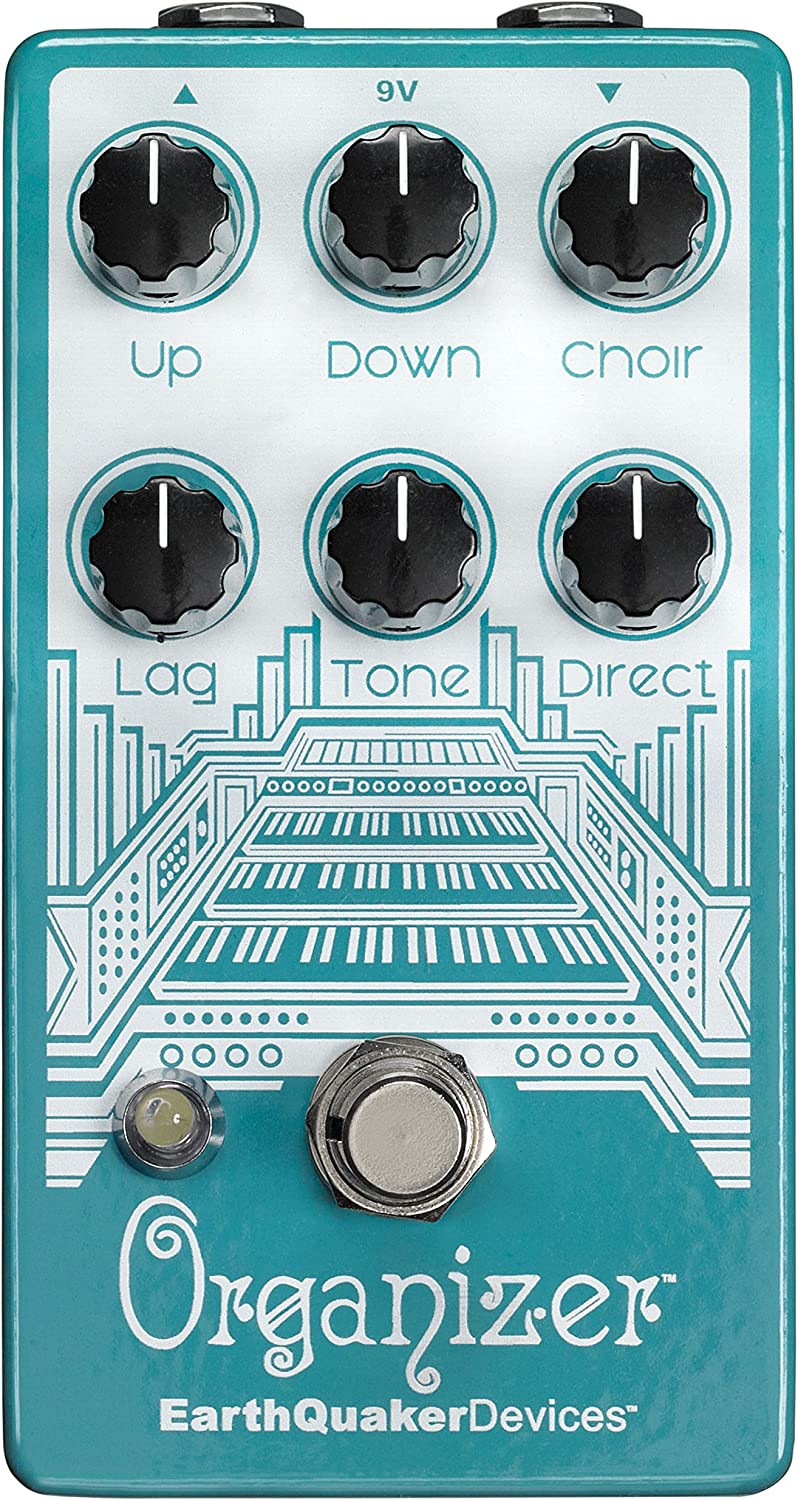
Crafted by Earthquaker Devices, the Organizer V2 is an exceptional polyphonic organ emulator pedal.
Its design seeks to replicate the timeless organ tones of the past, intertwining these with the unique tones of a “guitorgan”.
This fusion of vintage and modern sounds creates a warm and slightly warbling Leslie tone.
As a user, you can explore the device’s unique features, which include controls for octave up and down, direct, choir, tone, and lag.
This pedal embraces a wide range of sounds and sources; beyond guitars and bass, it proves equally effective with vocals, synths, drums, and even horns.
Incorporating a mix of analog and digital signal processing technology, the Organizer V2 ensures a pristine, all-analog dry signal path.
Each pedal is individually handcrafted in the gritty heart of Akron, Ohio.
With a manageable size and weight, it’s a gem that brings a vintage aura to your music setup.
- My Review
Immersing myself in the universe of sound offered by the EarthQuaker Devices Organizer V2 Polyphonic Organ Emulator Pedal, I’ve been intrigued by its unique capabilities.
I mean, who wouldn’t be?
It’s not every day that you stumble upon a device that attempts to resurrect the organ tones of yesteryear and blends them seamlessly with the distinct “guitorgan.” It’s a step back in time, only with a modern twist.
That said, it’s not all about nostalgia here. This pedal does have a mind of its own.
Is it sound? Warm, welcoming, and analog, with an unexpected Leslie warble that caught me off guard – in a good way.
What truly stands out, though, is its octave control.
Whether I’m experimenting with octave up, down, direct, choir, tone, or lag, this pedal responds with impressive precision.
It’s not just about single notes; it confidently tracks chords across the entire neck of a guitar or bass.
Broadening its appeal, the Organizer V2 is versatile enough to handle various sounds.
I’ve been testing it with vocals, synths, drums, and even horns.
If it produces sound, this pedal is up to the task.
This versatility and a mix of analog and DSP circuitry allow this pedal to shine.
Size and weight are always concerns for musicians; this pedal also nails it in those departments.
Compact and lightweight, it’s ready to journey wherever your music takes you.
Handcrafted individually in Akron, Ohio, each unit has its personal touch.
Here are the ratings I’ll give to the EarthQuaker Devices Organizer Organ Emulator Pedal:
True bypass switching and an all-analog dry signal path? Just the icing on the cake.
The EarthQuaker Devices Organizer V2? An unexpected yet fascinating twist on the familiar.
- Pros:
- Polyphonic organ emulation.
- Warm analog feel with Leslie warble.
- Tracks chords and single notes perfectly.
- Versatile use with various instruments.
- Combines analog and DSP circuitry.
- Cons:
- Limited control over individual organ parameters.
- May not suit all musical genres or styles.
- Higher price compared to similar products.
My final verdict is that the EarthQuaker Devices Organizer V2 Polyphonic Organ Emulator Pedal is a highly versatile and feature-rich pedal with excellent tone and performance.
The brand’s reputation adds to its appeal, and while it may have a higher price than similar products, it’s unique capabilities and handmade craftsmanship in Akron, Ohio, justify the investment.
It is a valuable tool for musicians who emulate vintage organ tones and explore creative possibilities.
Stax Guitar Harmonizer Pedal
High-sensitivity, polyphonic pitch shifting pedal with ±2 Oct range.
The Stax Harmonizer Effects Pedal provides accurate polyphonic pitch shifting with 44.1k 24bit sampling and 32 bit true floating point DSP. It features ±2 Oct Pitch Range and 16 adjustable parameters. Comes with a 9V DC adapter and user manual.
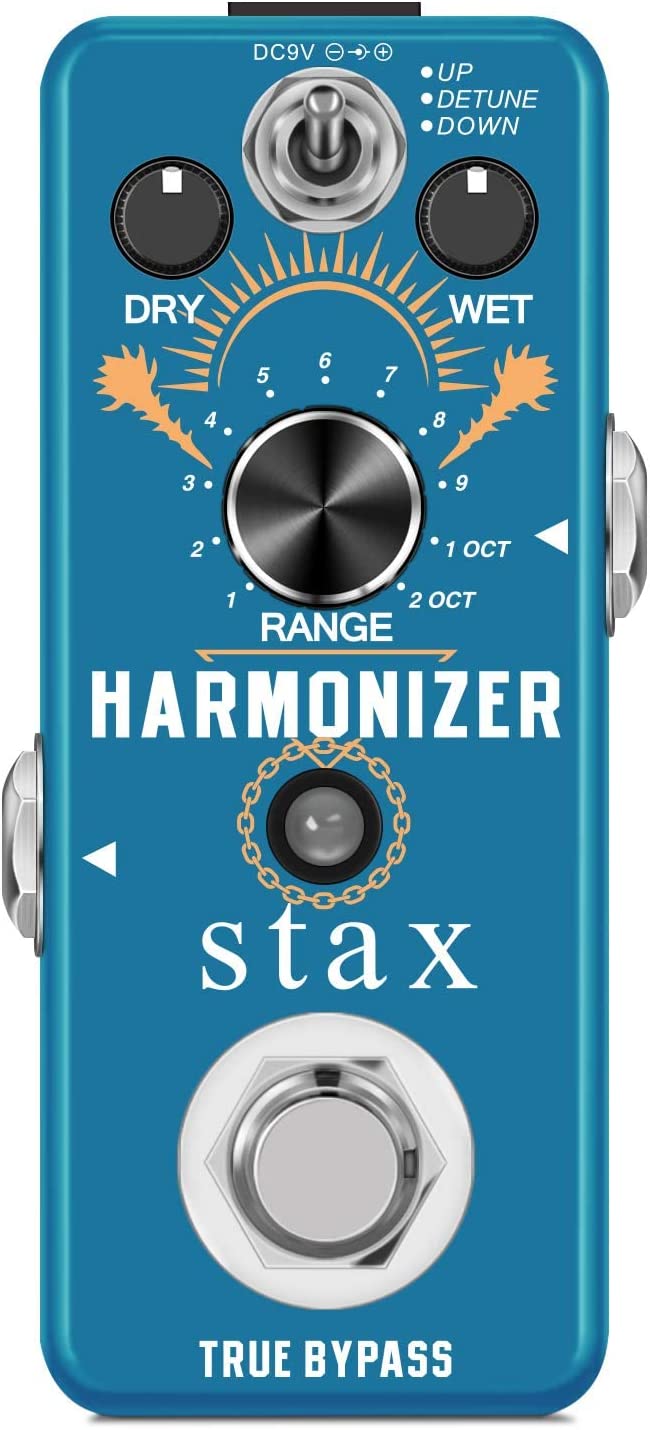
Let’s talk about the Stax Guitar Harmonizer Pedal.
This compact device has been engineered to enhance your guitar-playing experience by creating beautiful harmonies.
Its robust structure, encompassing a durable metal body, ensures a long-lasting relationship with your pedalboard.
You’ll appreciate the simplicity of its user-friendly interface.
A few dials and switches are all you need to fine-tune your output, making it a cinch for beginners and seasoned players.
Among these, the Blend knob stands out, helping you to maintain a perfect balance between your guitar’s original sound and the harmonized note.
Harnessing the power of the pedal’s tone is the advanced tracking system that guarantees accurate harmony generation, even with complex chords.
You’ll also discover many options in the two operating modes – Detune and Harmony, catering to a diverse range of soundscapes.
With your setup’s Stax Guitar Harmonizer Pedal, you can effortlessly transform your solos into rich, layered performances.
Time to amp up your guitar’s voice!
- My Review
Let’s jump right in; the Stax Guitar Harmonizer Pedal has significantly impacted my guitar-playing journey.
With its sturdy metal body, it was clear from the outset that it meant business.
It has been reliable, holding up well under daily use and showing no signs of wear and tear even after being carted to various gigs.
Working with the pedal was a breeze.
The interface is straightforward, and the controls intuitively make it a joy to fiddle with.
The Blend knob was a standout, allowing me to dial in the exact amount of harmony I desired.
Whether subtly enhancing a melodic line or ramping up the effect for a chorus, it was remarkable how precisely it catered to my needs.
A real highlight of this pedal was the harmonizing ability it offered.
The advanced tracking system is, frankly, astounding.
It took everything I threw at it – complex chords, fast runs, you name it, and it returned harmonies with pinpoint accuracy.
Truly, it felt like having an intuitive second guitarist by my side, harmonizing my playing in real time.
There’s a delightful versatility in the two modes of operation – Detune and Harmony.
Detune mode added a unique richness to my sound, subtly shifting pitches to create a thicker sonic texture.
On the other hand, Harmony mode offered a broader range of possibilities, adding beautifully tuned harmonies to my guitar lines.
I wish a wider range of harmony intervals were available, but it’s a small complaint in an otherwise stellar product.
In my hands, the Stax Guitar Harmonizer Pedal transformed my solos from simple melodies into lush, multi-layered performances.
Here are the ratings I’ll give to the Stax Guitar Harmonizer Pedal:
It added a new dimension to my sound, breathing life into my playing and elevating my musical expression.
I believe this pedal could be a game-changer for ambitious guitarists looking to spice up their sound.
- Pros:
- Low price.
- Accurate and sensitive knobs.
- Compact and sturdy design.
- Versatile pitch-shifting effects.
- Good quality for the price.
- Cons:
- Latency issue in wet signal.
- Not suitable for certain uses (e.g., detuning).
- Sound quality could be better.
- Some units may arrive scratched or damaged.
- May require additional adjustment for optimal performance.
My final verdict is that the Stax Guitar Harmonizer Pedal offers decent versatility and features, although it may have some drawbacks in terms of tone and performance.
The brand receives favorable feedback, and the product provides good value for its price.
Overall, it can be a suitable choice for those seeking an affordable harmonizer pedal, with some considerations regarding latency and sound quality.
MOOER Pure Octave Precise Pedal
High-quality, no-distortion polyphonic octave effects.
The OC-3 Super Octave pedal from Boss offers precise polyphonic octave effects with no distortion. It features two selectable octave modes, direct signal blend, and a built-in compressor for smooth sounds. Perfect for guitar and bass players alike.
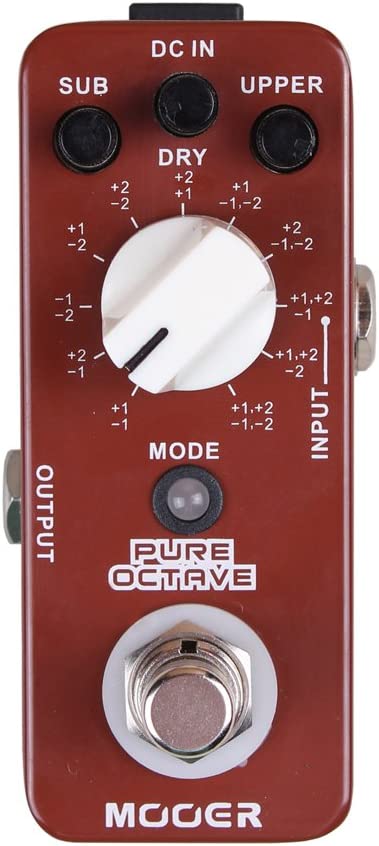
Crafted with precision, the Mooer Pure Octave pedal brings you a vibrant sonic palette.
This compact gadget empowers you with 11 modes, delivering anything from subtle octave harmonics to radical pitch shifts.
With its intuitive design, you can fine-tune the SUB, DRY, and UPPER knobs to mold the sound you desire, whether it’s slight textural enhancement or a seismic shift in pitch.
Prized for its tiny footprint, this pedal snugly fits into even the most crowded pedalboard, sparing you the hassle of rearranging your setup.
Its sturdy metal housing assures durability, standing up to the rigors of on-stage performances and studio sessions.
Powered by a 9V power supply, the Mooer Pure Octave is easy to integrate into your rig.
Plus, with true bypass switching, your guitar’s original signal path remains undisturbed when the pedal is switched off, maintaining tone integrity.
The device is designed to deliver both flexibility and simplicity, paving the way for experimental and traditional playing styles.
- My Review
Diving right in, I found the Mooer Pure Octave pedal to be a potent tool in my arsenal.
Immediately, its compact size stood out.
Despite the miniaturized design, it lost none of its punch – a pleasant surprise.
Able to find a place on even the most crowded of pedalboards, its small footprint became a point of admiration.
Now, speaking about its performance, I found its variety in terms of modes quite remarkable.
Eleven distinct modes are no small feature, and the versatility was apparent as soon as I started experimenting.
From subtle harmonic augmentations to full-on pitch transformations, playing around with this device was a joy.
Operation-wise, it couldn’t have been more straightforward.
I discovered many tone possibilities by adjusting the SUB, DRY, and UPPER knobs.
This pedal didn’t merely accommodate different playing styles; it invited exploration and rewarded creativity.
Construction-wise, the Mooer Pure Octave is built to last.
The metal housing shrugged off my rigorous use, a testament to its durability.
I also noticed that when the pedal was turned off, it didn’t interfere with the original signal, a feature I particularly appreciate.
But, I did find that the pedal required precision when dialing in the desired settings.
A tiny movement could drastically change the sound.
While this allows for highly specific tweaking, it might take some getting used to.
Another point I’d like to make is that the pedal only operates with a 9V power supply.
It’s not a major drawback, but it’s something you might want to keep in mind if your setup differs.
In my book, the Mooer Pure Octave Pedal certainly stands out.
Here are the ratings I’ll give to the MOOER Pure Octave Precise Pedal:
Its compact design, versatility, and robust build make it a worthy consideration for those seeking to expand their tonal possibilities.
Yet, its sensitive controls and specific power requirement might warrant some consideration.
- Pros:
- Compact and space-saving design.
- Precise polyphonic octave effects.
- Offers 11 different octave modes.
- Sturdy full metal shell construction.
- True bypass for clean signal pass-through.
- Cons:
- Not suitable for bass.
- Potential quality issues reported by some users.
- Limited negative reviews.
My final verdict is that the MOOER Pure Octave is a solid choice for those seeking precise polyphonic octave effects in a compact pedal.
Its 11 octave modes, sturdy construction, and true bypass functionality offer versatility and good performance.
The positive reviews highlight its quality tone and value for the price.
However, a few reported cons exist, including its limited suitability for bass and occasional quality issues.
Considering its brand reputation and positive attributes, the MOOER Pure Octave is a worthwhile option for musicians looking to incorporate octave effects into their setup.
Pulse PT-37 Harmonizer Pitch Shifter Pedal
Pulse PT-37 Harmonizer for pitch shifting with up/down octave options and store function.
Pulse PT-37 Harmonizer Pedal offers up to 2 octave pitch range, plus 11 set dials, soft touch switching, and true bypass circuitry for enhanced sound layering. Compact design makes it ideal for the traveling guitarist with a store function to save any configuration of sound.
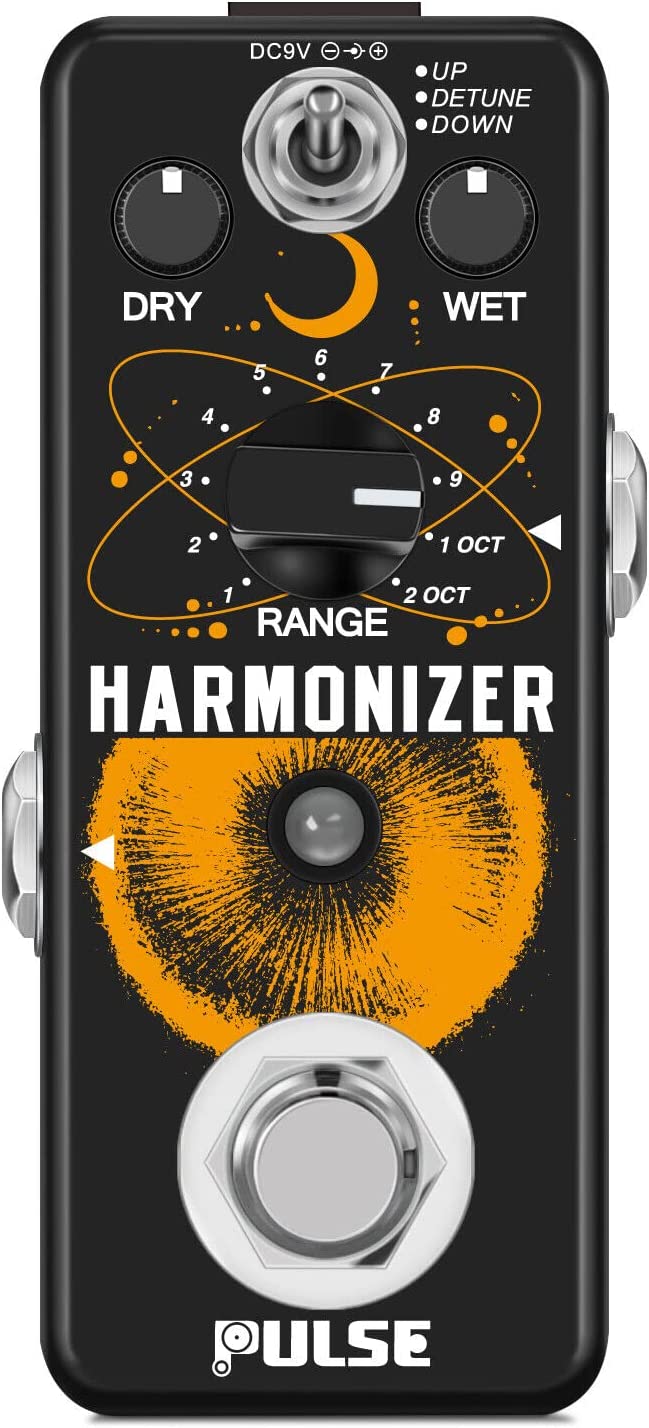
Meet the Pulse PT-37, a pitch shifter pedal with guitarists buzzing.
This versatile little device sports two modes of the octave to select from and eleven different pitch shift settings – that’s a wealth of unique tones at your disposal!
It’s compact, but don’t be fooled by its size – it’s bursting with features.
Have you ever wanted to store your favorite effects configuration for a quick recall?
The Pulse PT-37 has you covered with its handy store function.
Its operation is simple: it’s equipped with a Dry and Wet set option, letting you control the volume of both original and altered signal sounds.
This nifty pedal can take your guitar’s sound to new heights or delve deep into richer, lower tones while retaining clarity.
And speaking of controls, it’s all touch-based, which makes for effortless sound adjustment.
Here’s something cool: the PT-37 can create a layered sound by duplicating the original sound and altering its frequency.
Now that’s what you call playing with depth and undertones!
And last but not least, this electric-powered pedal is built for durability with its zinc alloy shell and 3DPT switch.
All this in a pedal that fits right in your palm – impressive.
- My Review
Straight out of the box, I was taken aback by the compact size of this pedal – a mini beast packed with a punch, if you will.
Nestling into my palm, the zinc alloy shell radiated a robust assurance that this baby was designed to withstand a lot.
Plugging it in, I found myself marveling at the interface’s intuitiveness.
My fingers naturally found their way to the Dry and Wet set options, tweaking the volume of the original and altered signal sounds.
Unleashing the beast, I was greeted by a symphony of tones, each richer and more unique than the last.
What an auditory delight!
Experimenting with the 11-set pitch dial was a trip.
The range of pitch shifts had me journeying from bright, almost angelic tones to earth-shaking, profound notes.
I found myself drawn to play with up to 2 octaves, bringing out a new dimension in my guitar’s voice.
One feature that won me over was the built-in store function.
The convenience of saving and quickly recalling my favorite configurations? Pure genius!
To top it off, the pulsing pedal can duplicate and alter the frequency of the original sound, allowing me to layer the sounds like a pro.
However, it wasn’t all rainbows. I did find the power supply to be a bit of an issue.
A 9V DC, which is not included? It would’ve been a much-appreciated addition.
Here are the ratings I’ll give to the Pulse PT-37 Harmonizer Pitch Shifter Pedal:
Also, at times, the pedal seemed to draw more power than expected.
That said, my time with the Pulse PT-37 was an adventure, and it’s a solid option for anyone searching for rich tones and enhanced guitar sounds.
- Pros:
- Compact and mini design.
- Wide range of pitch-shifting options.
- Built-in store function for saving configurations.
- Straightforward interface for easy use.
- Cons:
- May require additional power supply (not included).
- Input and output connectors limited to 1/4″ TS Jack.
- No mention of additional advanced features or effects.
My final verdict is that the Pulse PT-37 Harmonizer Pitch Shifter Guitar Effect Pedal is a highly versatile and feature-rich pedal that delivers excellent tone and performance.
It offers a wide range of pitch-shifting options and a built-in store function for convenient configuration saving.
While the brand may not be as well-known, the pedal provides great value for its price.
Overall, it is a recommended choice for guitarists looking to enhance their sound with pitch-shifting effects.
Eventide PitchFactor Harmonizer Pitch Pedal
Studio-quality sound in a compact, upgradeable pedal.
Eventide PitchFactor offers studio quality pitch+delay effects in a portable, affordable stompbox. Enjoy plug-and-play expression pedal control with up to 4 voices of diatonic pitch shifting, 1.5 seconds of stereo delay, MIDI control, and more. Upgradeable software and true bypass make it perfect for any pedalboard.
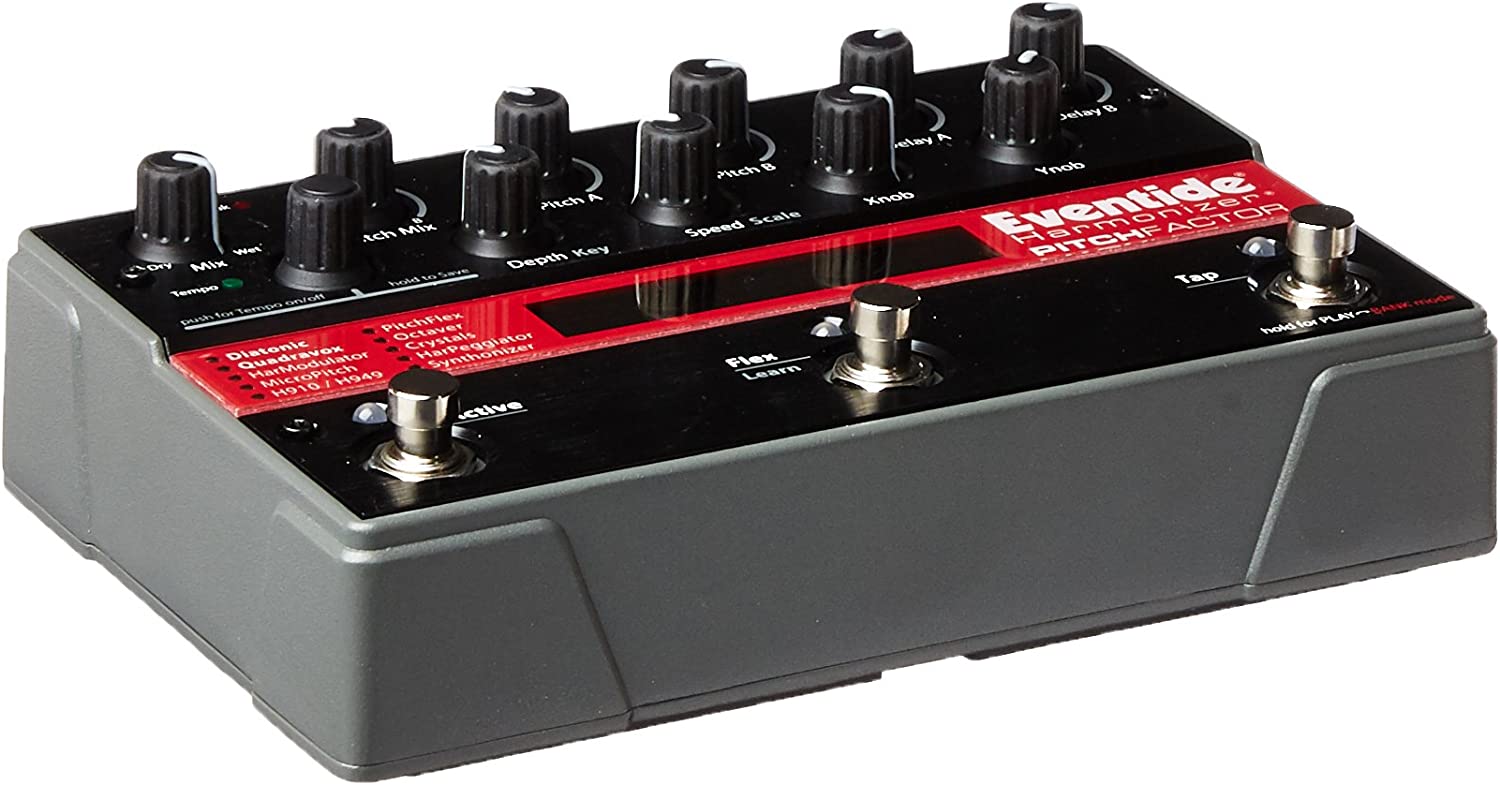
This is the PitchFactor Harmonizer Pedal from the reputed brand, Eventide.
Exhibiting a compact style, the device basks in a sleek, red hue and weighs a mere 3.9 pounds with dimensions of 13 x 7.5 x 4 inches.
This device is mindfully designed as a sturdy tool for musicians, compatible with both guitar and bass, presenting four voices of diatonic pitch shifting coupled with up to 1.5 seconds of stereo delay.
Its supreme audio quality is comparable to that of top recording studios worldwide.
Among its attention-grabbing features, the PitchFactor pedal boasts a built-in tuner and the convenience of software updates via USB 2.0. Engineered to adapt seamlessly with a wide array of amps and foot pedals, it plays well with other music gear.
It’s a marvel that packs studio-grade effects into an affordable, portable box.
With Eventide’s PitchFactor Pedal, high-quality sound is always at your feet.
- My Review
Stepping into the shoes of a guitarist, as fingertips brushed the Eventide PitchFactor Harmonizer Pitch+Delay Pedal, what stood out initially was its sleek red color and compact design, a beacon of sophistication amongst music equipment.
From a brand like Eventide, expectations were set high and true to form; the pedal didn’t disappoint.
As I explored its functionalities, this Harmonizer Pedal proved to be cosmic.
It offered a staggering four voices of diatonic pitch shifting and 1.5 seconds of stereo delay – a unique blend that substantially expanded my musical horizons.
It was also refreshing to see that the device didn’t restrict itself to guitars alone but extended its compatibility to bass instruments.
An immediate highlight was its studio-level sound quality.
This little pedal beast served up the audio on par with equipment found in premier recording studios.
It effortlessly wielded its sonic power, transforming an ordinary jam session into something reminiscent of a high-end studio recording.
A built-in tuner was an additional boon, eliminating the need for a separate gadget.
The convenience of software upgrades via USB 2 was almost too good to be true – a testament to Eventide’s attention to an evolving music scene.
One thing that truly hit the music nerd in me was the careful consideration of interoperability.
Eventide’s PitchFactor Harmonizer Pitch+Delay Pedal communicated beautifully with a wide range of amps and foot pedals – a priceless attribute in music.
Yet, the real treat lay in the sheer versatility of this pedal.
It blurred the lines between a gig bag essential and a home studio superstar.
Whether I was jamming at home or on a live stage, this pedal never missed a beat.
Here are the ratings I’ll give to the Eventide PitchFactor Harmonizer Pitch Pedal:
It was practical affordability merged with uncompromised functionality.
Eventide PitchFactor, you nailed it!
- Pros:
- Wide range of sonic possibilities.
- High-quality studio sound.
- Versatile compatibility with guitar and bass.
- Built-in tuner for convenience.
- Software upgradeable via USB 2.0.
- Cons:
- Steep learning curve for beginners.
- Relatively high price point.
- May require additional pedals for certain effects.
My final verdict is that the Eventide PitchFactor Harmonizer Pitch+Delay Pedal is a highly versatile and feature-rich pedal that offers excellent tone and performance.
The brand’s reputation for quality and the ability to upgrade the pedal via USB 2.0 are additional strong points.
However, it may have a steep learning curve for beginners, and the relatively high price point and the potential need for additional pedals for certain effects might be a drawback for some.
Considering its strengths and weaknesses, the Eventide PitchFactor Harmonizer Pitch+Delay Pedal is a positive recommendation for musicians seeking a powerful and flexible pedal for their guitar or bass setup.
Rowin Harmonizer Digital Guitar Effect Pedal
Rowin LEF-3807 Harmonizer offers precision pitch shifting and true bypass.
Rowin LEF-3807 is a polyphonic pitch shifter/harmonizer pedal with a ±2 octave range, 3 wet/dry knobs, and 9 pitch intervals. It offers true bypass for an uncolored sound and a 3-way toggle switch for up tuning, down tuning, and detuning. Easy to install and use, it brings a serious depth and warped undertones to your guitar.
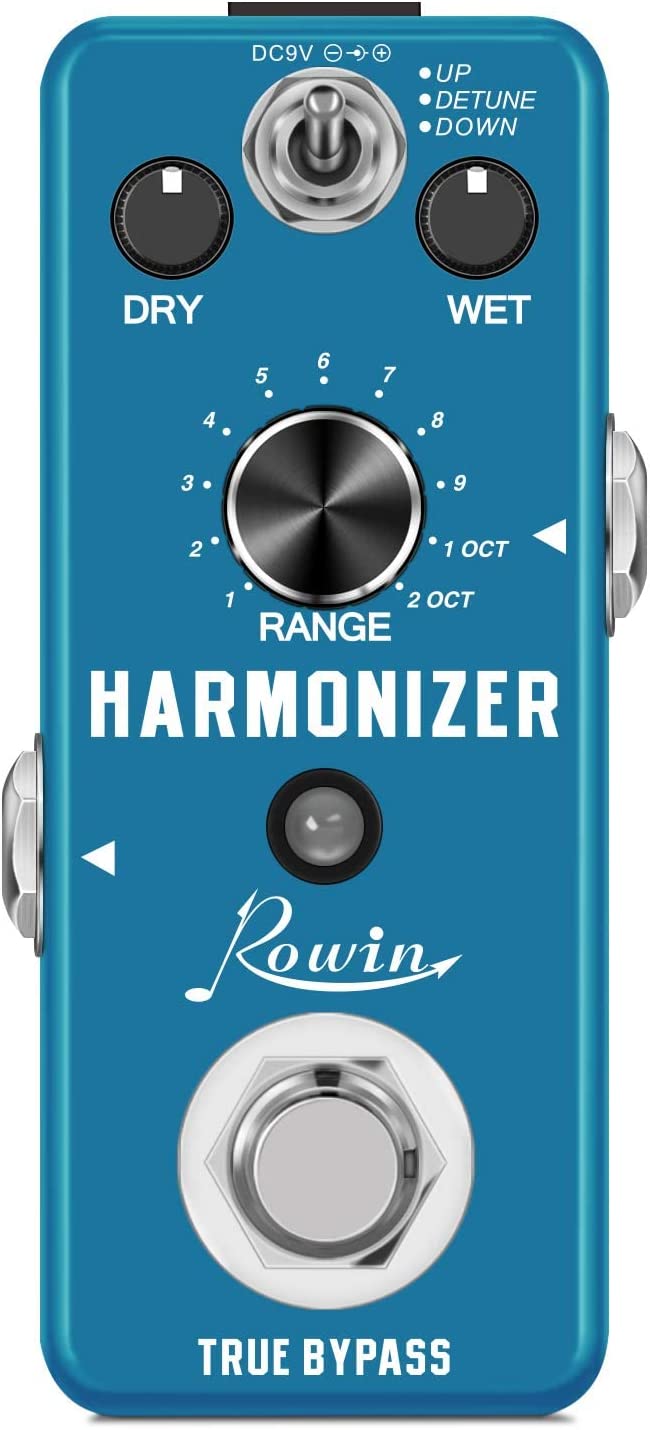
Regarding small yet powerful guitar effect pedals, the Rowin Harmonizer Digital Guitar Effect Pedal stands out among the rest.
This compact unit provides polyphonic pitch shifting while delivering perfect sound control.
The design features a Range dial, Wet and Dry controls, which offer the ultimate versatility for tailoring your desired sound effect.
You can select between Up, Detune, and Down modes, thanks to the handy 3-way toggle switch.
To top it, its true bypass footswitch ensures an uncolored guitar sound and a smooth pedal engagement.
Its sampling quality captures attention, delivering a 44.1kHz/24bit output powered by a 32 BIT floating point DSP.
Despite its mini size, it’s notably heavy-duty.
The pedal weighs around 253 grams, and its dimensions are 3.74 x 1.77 x 1.89 inches, allowing easy portability.
This nifty device, encased in a vibrant blue durable zinc alloy, embodies the saying ‘good things come in small packages.’
- My Review
Stepping into the world of Rowin Harmonizer Digital Guitar Effect Pedal felt like a journey into endless tonal possibilities.
From the moment I picked it up, its compact size gave away nothing of its powerful capabilities.
Despite its modest size, every ounce of its 253-gram weight was a testament to its sturdy build and robustness.
Armed with polyphonic pitch-shifting capabilities, I was met with exceptional sound precision that surpassed my expectations from a pedal of this size and price range.
The Wet and Dry controls added an extra layer of customizability that shaped the output to my liking.
It was like holding a symphony orchestra in the palm of my hand, able to compose in any way I wanted.
The convenience of the 3-way toggle switch that let me flip between Up, Detune, and Down modes left me in awe.
The seamless transition between modes was a smooth sail and kept the uncolored nature of my guitar tone intact.
Indeed, things aren’t always easy to navigate.
Still, the user-friendly nature of this harmonizer pedal ensured I experienced little to no disruption, even when making significant mode shifts.
What truly marveled me was the pedal’s sampling rate at a whopping 44.1kHz/24bit, powered by a 32-bit floating point DSP.
I could pick out every note with stunning clarity, significantly enhancing my playing experience.
Notably, the pedal doesn’t come with a power supply, although it operates on 9V DC, which might be an extra thing to consider before purchasing.
Here are the ratings I’ll give to the Eventide PitchFactor Harmonizer Pitch Pedal:
There is just the right amount of criticism here, but using the Rowin Harmonizer Digital Guitar Pedal was an instrumental delight.
From its reliable build to its impressive sound quality and control versatility, it was clear to me that this pedal packs a punch in the realm of guitar effects pedals.
- Pros:
- Compact and robust design.
- Polyphonic pitch-shifting capabilities.
- User-friendly controls.
- Cons:
- Power supply needs to be purchased separately.
- May require an initial learning curve.
- Ideal sound quality requires a good setup.
My final verdict is that the Rowin Harmonizer Digital Guitar Effect Pedal is a compact powerhouse with impeccable sound quality, easy-to-use features, and considerable value for its cost.
Despite its minor drawbacks, it performs exceptionally and can be an excellent addition to any musician’s kit.
Its versatility propels it beyond just being a neat gadget into a serious musical tool that delivers impactful effects.
Digitech Mini Pitch Acoustic Guitar Effect Pedal
Classic whammy sound with modern, customizable controls.
The WHAMMY RICOCHET creates classic whammy pitch-shifting sounds and unique new tones with a momentary switch, customizable independent Rise and Fall time ballistics, and 7 selectable pitch intervals. It also features a toggle switch to select up or down for the selected pitch and a latching footswitch mode.
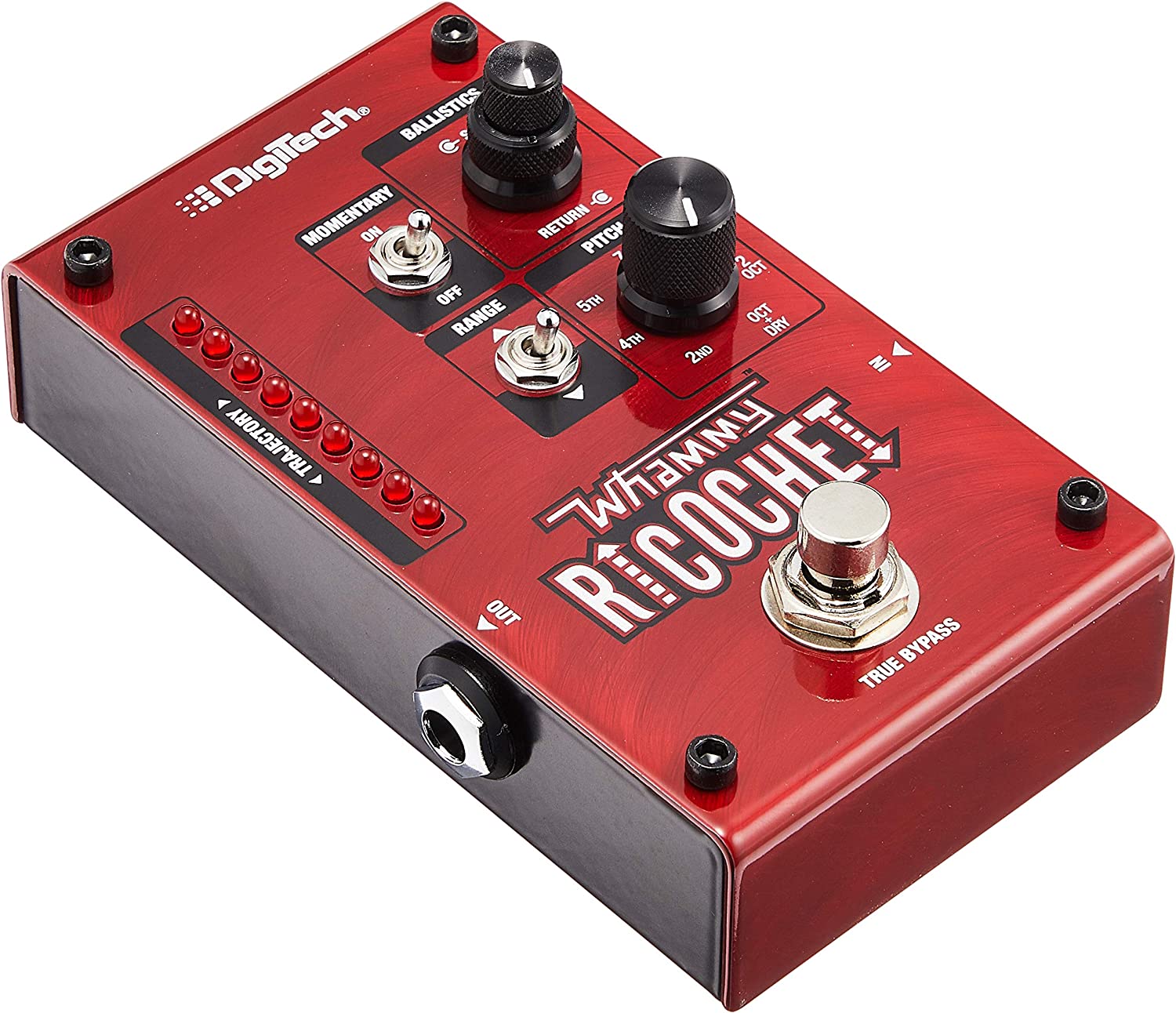
Meet the DigiTech Whammy Ricochet, a compact but mighty guitar effect pedal colored in a vibrant red.
Known for replicating the iconic whammy sound, it does so without requiring a cumbersome treadle.
This handy pedal lets musicians bend their notes up or down across a range of two octaves, with seven-pitch intervals to choose from.
With total authority over the shift and return time, users can easily create custom soundscapes.
Another interesting feature is an LED Trajectory Ladder, a visual guide that offers immediate feedback.
Crafted for convenience, it quantifies comfort with its dimensions of 4.75 x 2.88 x 1.75 inches and a lightweight of 0.4 pounds.
This DigiTech pedal launches you to new performance levels, allowing you to emulate your musical inspirations without transforming your equipment setup, delivering classic whammy pitch-shifting and unique sounds yet to be discovered.
- My Review
This DigiTech pitch acoustic guitar effect pedal, aptly named the Whammy Ricochet, is compact, portable, and striking in its vibrant red color.
The thing that caught my attention right off the bat was its compactness.
You’d think something this small would compromise performance, but surprisingly, it didn’t.
The pedal manages to deliver that legendary Whammy sound without the need for a bulky treadle.
I was pleasantly surprised by its pitch-bending capabilities, too – it gives you the freedom to warp your notes up or down within a generous span of two octaves.
Moreover, the selection between seven-pitch intervals provides ample room for customization.
But here’s where it gets interesting.
This pedal offers ultimate control over shift and return time, allowing tailored pitch shifts.
Paired with a responsive footswitch, it allows rapid pitch transitions without lag – an important aspect that adds to its user-friendliness and seamless operation.
An unexpected but appreciated feature is the LED Trajectory Ladder.
It offers immediate visual feedback, handy for on-the-go adjustments during a live performance.
It’s unlike anything I’ve seen before; trust me; it’s a game-changer.
It’s not all sunshine, though.
I noticed that the Ricochet fell a bit short as an octave pedal.
It seemed to change the guitar tone considerably, reducing its versatility.
Also, while the pedal comes in a compact design, the lack of an included power supply felt like an oversight, especially considering its price point.
On the whole, the DigiTech Whammy Ricochet is a fun pedal to have on your board.
Here are the ratings I’ll give to the Digitech Mini Pitch Acoustic Guitar Effect Pedal:
It not only delivers the good ol’ Whammy pitch-shifting but takes it up a notch with unique sounds that will tickle the fancy of the bold and adventurous musician.
Remember, it’s not your quintessential octave pedal, so choose wisely.
- Pros:
- Compact and portable design
- Robust pitch-bending capabilities
- Unique LED Trajectory Ladder
- Cons:
- Falls short as an octave pedal
- Alters guitar tone significantly
- Lacks included power supply
My final verdict is that the DigiTech Whammy Ricochet is a versatile and unique guitar effect pedal.
Despite a few drawbacks, it’s innovative features and robust performance make it a worthwhile investment.
Boss PS-6 Harmonizer Guitar Effects Pedal
High-quality pitch shifting with four effect modes in one pedal.
This Boss PS-6 Harmonist pedal is in good condition and provides four intelligent pitch-shift effects and three-voice harmony for creative sound manipulation. It features Harmony, Pitch Shifter, Detune, and Super Bend modes, plus selectable key and voicing for two- or three-voice harmonies.
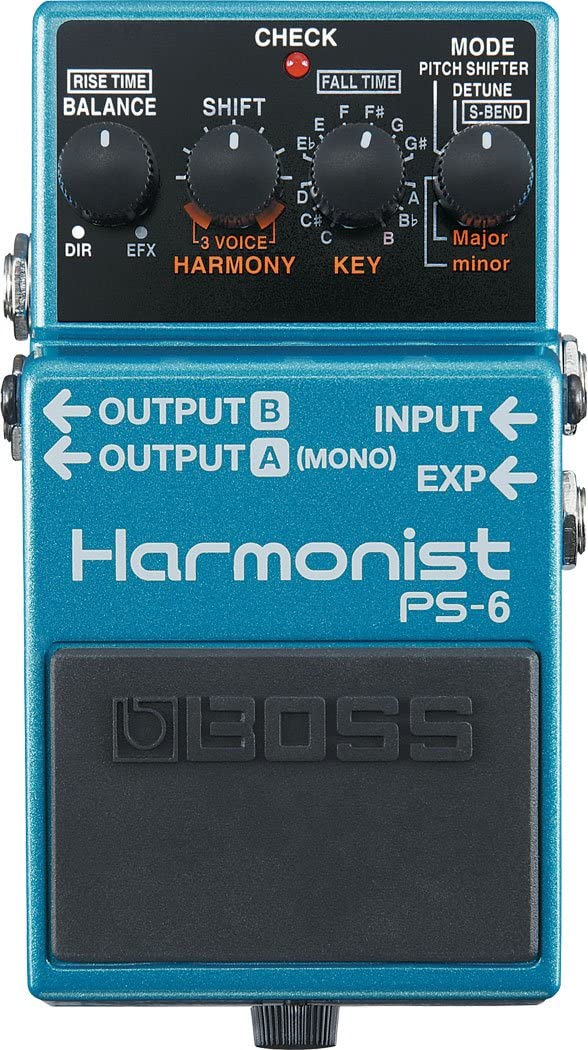
Presenting the Boss PS-6 Harmonizer, a unique guitar effects pedal is flaunting a compelling blend of advanced features and functionalities.
It is a multifaceted tool for musicians, furnished with four different effect modes—Harmony, Pitch Shifter, Detune, and S-BEND (Super Bend).
The pedal’s capability to produce two- or three-voice harmonies with a choice for key and voicing is a highlight, along with high-end pitch shifting.
The Detune feature works in three voices offering a distinct experience.
The pedal can furnish up to four octaves of intense pitch bending by showcasing the groundbreaking Super Bend mode.
Fashioned in the hues of teal and black, this harmonizer weighs only one pound and operates at 9 volts.
It’s physical appearance and performance unerringly uphold the Boss brand values.
It’s worth noting that it’s in a good state of upkeep, bearing minor aesthetic issues like pre-Velcro use.
It’s been celebrated among users for its intelligence in delivering pitch-shifted effects and harmonies.
- My Review
Upon trying the Boss PS-6 Harmonizer Guitar Effects Pedal, I found it to be quite an interesting piece of gear.
Coming equipped with four different effect modes, namely Harmony, Pitch Shifter, Detune, and the forward-thinking S-BEND (Super Bend), this pedal shows its prowess as a multi-tool in blending diverse sounds.
Creating harmonies, be it two or three voices, is a walk in the park with this device.
It offers the flexibility to select your desired key and voicing, setting the stage for creative exploration.
Moreover, my experience with the pitch-shifting feature was noteworthy.
It churns out high-quality shifts, significantly influencing the overall music quality.
Adding further to the PS-6 Harmonizer’s charm is the Detune feature.
It can offer a three-voice experience and is a testament to this pedal’s versatility.
However, the show’s star for me was the Super Bend mode.
The ability to provide up to four octaves of intense pitch bending was amazing.
Regarding the physical characteristics, this teal and black pedal weighs about one pound and operates at a voltage of 9 Volts.
The lightweight nature and relatively small size make this an ideal pedal for gigging musicians.
However, it does come with some minor pre-Velcroed aesthetic issues, but nothing that hinders the device’s performance.
Despite its many perks, I did find that the Harmonizer had its quirks.
The tracking system can be finicky if the strings aren’t perfectly tuned.
It’d be more helpful if this aspect were a bit more forgiving.
All things said, my take on the Boss PS-6 Harmonizer Guitar Effects Pedal is largely positive.
Here are the ratings I’ll give to the Boss PS-6 Harmonizer Guitar Effects Pedal:
It’s this guitar enthusiast’s dream, given its robust capabilities, compact design, and remarkable performance.
It’s quite a thorough package for any musician looking to enrich their sonic palette.
- Pros:
- Variety of effect modes available.
- High-quality pitch shifting feature.
- Compact, lightweight, and portable.
- Cons:
- Minor pre-Velcroed aesthetic issues.
- Sensitive to instrument tuning.
- Advanced features may intimidate beginners.
My final verdict is that the Boss PS-6 Harmonizer Guitar Effects Pedal is a competent, well-rounded multi-tool that can elevate your creative process.
Its versatility and high-end features offer a fresh musical experience.
Despite minor hitches, such as sensitivity to instrument tuning, the pedal’s performance stands out and blends well with the brand’s reputation for quality.
For its price range, it delivers impressive value, making it a worthy investment for casual and professional musicians alike.
EarthQuaker Devices Rainbow Machine Pitch-Shifting Modulator Pedal
Create out-of-this-world sounds with the EarthQuaker Rainbow Machine V2.
Rainbow Machine creates unorthodox sounds with modern DSP, offering real-time pitch shifting and synthetic tones. Ideal for experimenters, adventurists, and noisemakers, it’s perfect for sonic exploration.
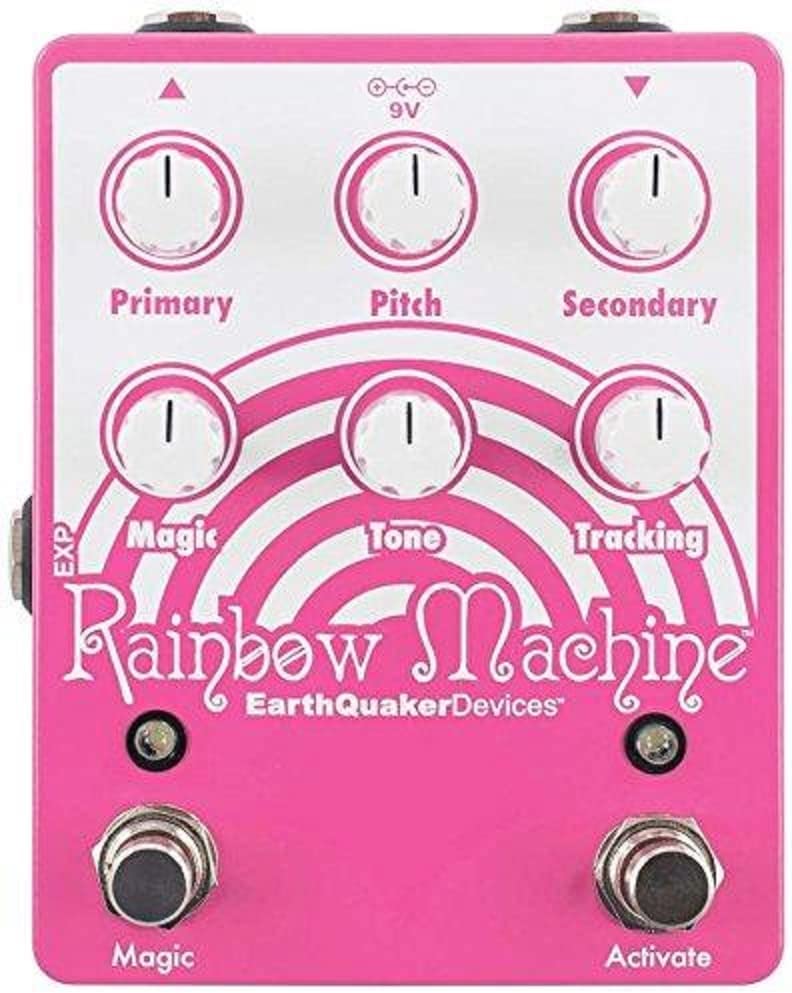
Meet the Rainbow Machine by EarthQuaker Devices, a guitar pedal designed for the audacious and the explorers of sound.
This is not your average pedal; it’s the key to a sonic universe full of rainbow colors.
With a modern digital signal processor (DSP) under its hood, the Rainbow Machine creates unique pitch shifting in real time through the science of digital oscillators.
Its controls offer primary and secondary tracking, a flexi switch, and options for pitch adjustment.
Dressed in vibrant pink and white, this compact pedal measures roughly 5.65 x 4.35 x 3.25 inches and weighs around 1.17 pounds.
A creation from EarthQuaker Devices, Rainbow Machine stands out in quality and durability.
It is created to bring out unconventional sounds suited for music creators who enjoy experimenting outside the norm.
But remember, the sounds you get from it are anything but natural; they’re magical!
- My Review
When stepping into the realm of the Rainbow Machine V2 Polyphonic Pitch-Shifting Modulator Pedal by EarthQuaker Devices, you’re truly stepping into a world unknown.
This isn’t a pedal for the faint of heart or those chasing traditional sounds; it’s a beast designed for creating the extraordinary.
Wielding the Rainbow Machine brings with it a thrilling sense of uncharted territory.
Powered by a modern digital signal processor, it delivers exhilarating real-time pitch shifting.
It’s like holding a magical, sonic paintbrush, capable of painting wild audible pictures in bold, fluorescent colors with each strum.
Exploring its interface, you’ll uncover pitch controls, a secondary knob, and a flexible switch.
This range of adjustment lets you dial in precise soundscapes.
It’s small and relatively lightweight, making it easy to journey with.
The super chic pink and white color scheme makes it a definite eye-catcher.
But bear in mind; the Rainbow Machine can be temperamental.
The sounds it emits are unique, perhaps even eccentric.
They may take time to understand, and some may seem unpleasant or elusive.
But if you invest the time, you’ll reach a universe of unexplored and psychedelic sounds.
Its price tag could be a bit of a hindrance, considering it might not be your go-to pedal for conventional, everyday use.
However, the lush and detailed sounds it can produce ultimately justify its cost.
Here are the ratings I’ll give to the EarthQuaker Devices Rainbow Machine Pitch-Shifting Modulator Pedal:
This pedal dares you to take risks and challenge the norm.
So, if you’re an adventurous soul craving to venture into the unknown and make some cool noise, the Rainbow Machine by EarthQuaker Devices may be the ticket.
- Pros:
- Creates unique, psychedelic sounds.
- Easy-to-use pitch controls and flexi switch.
- Compact, lightweight and stylistically designed.
- Cons:
- Can produce some unpleasant sounds.
- Limited use due to unique sonic output.
- Could be considered pricey for specific usage.
My final verdict is that the EarthQuaker Devices Rainbow Machine V2 Polyphonic Pitch-Shifting Modulator Pedal is a fascinating product for audiophiles who crave extraordinary sounds.
Its modern digital signal processing capabilities push the boundaries of what a guitar pedal can do.
Despite its unique tone output, which may not appeal to all musicians, it’s an exciting tool for those seeking an adventurous music journey.
Its robust features and atmospheric performance bring an unfathomable charm and intrigue.
Some might question the value for money due to its specialist nature, but for its niche, it stands out.
So, if you’re an audacious sound explorer, this could be an exciting addition to your sonic arsenal.
It’s a well-crafted, top-notch product from an esteemed brand seeking to experiment with the conventional norms of music creation.
Boss VE-2 Vocal Harmonist Effects Processor Pedal
Legendary BOSS quality for on-stage, studio, and home use.
BOSS is a trusted music technology brand offering durable, reliable, and high-quality products for guitarists and musicians. Their products are designed for maximum performance on stage, in the studio, and at home.
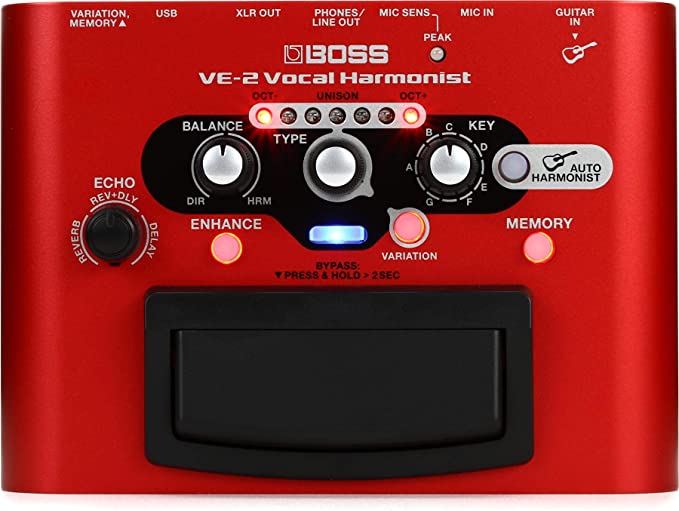
Helping you perfect your onstage performance is the Boss VE-2 Vocal Harmonist Effects Processor, a device that effortlessly adds flawless harmony to your vocals.
This battery-operated processor is compact yet equipped with 24 different harmony settings.
Coupled with its impact-resistant enclosure designed in mixed colors, it sports a treadle and an array of manageably sized knobs that promise commanding control over the sound effect.
Offering more than just vocal harmonies, this device lets you layer your performance with additional studio-like processing, reverb, and delay.
It also has a plug-in for your guitar, which lets the processor pick chordal cues from it to create matching harmonies.
Keeping it portable is its four AA batteries’ necessity, while USB connectivity ensures studio-friendly adaptability.
This compact tool would undoubtedly be a game-changer for performers, solo artists, and recording musicians.
- My Review
Spending some quality time with the Boss VE-2 Vocal Harmonist Effects Processor, I discovered a world of musical possibilities at my fingertips.
Undoubtedly, one of the standout features is this compact device’s superb vocal processing.
Whether you yearn for the perfect harmony or crave studio-like effects, access to 24 diverse harmony settings puts you firmly in the driver’s seat.
What a relief it was that you don’t need to be a music gear guru to use the VE- overall, an amazing user-friendly experience.
Bringing out those ideal harmonies has never been easier.
No complaints about ergonomics either- the controls’ medium-sized layout ensure the controls are quick to navigate.
Honestly, I found the case printing rather challenging to read in low-light conditions.
It wasn’t a deal-breaker, but something to bear in mind.
In terms of sound, it’s a genuine marvel.
The authenticity of the harmonies is impressive, creating a rich vocal tapestry that made my performances come alive.
However, the blend of reverb and chorus in a single control limited my flexibility and left me wishing they were separate controls.
Running solely on four AA batteries is a steal regarding portability, and I appreciated the option to plug into USB for studio sessions.
It does not come with a power supply, which could inconvenience some.
Remarkably, this all-in-one device connected to my guitar like a dream and seemed to have some kind of sonic sixth sense, generating harmonies on the fly that was perfectly in tune with my chords.
An issue, though, was the blue harmonizing light’s positioning, often obscured by foot, making it problematic to know when the harmonization was active.
One thing’s for sure; the Boss VE-2 Vocal Harmonist Effects Processor is a sound investment, boasting premiere quality and versatility.
Here are the ratings I’ll give to the Boss VE-2 Vocal Harmonist Effects Processor Pedal:
It’s not without its quirks, but if you’re willing to accommodate them, it can improve your musical journey.
Complete powerhouses come in small packages, after all.
- Pros:
- Exceptional vocal processing and harmony creation.
- Ideal for both stage and studio use.
- User-friendly and easily navigable controls.
- Cons:
- Hard-to-read instructions in low light settings.
- Combo control for reverb and chorus limits flexibility.
- Does not come with a power supply.
My final verdict is that the Boss VE-2 Vocal Harmonist Effects Processor is a compact but powerful device with immense potential.
Despite a few quirks, its impressive harmony creation, stage studio adaptability, and easy usage make it worth considering for ambitious vocal performers.
Boss’ reputation as a trusted brand further validates the VE-2 as an instrument that delivers value.
This is indeed a tool that could enhance the sonic richness of your performances.
Donner Octave Guitar Pedal
Donner Octave Pedal for flexible control and pure tone.
The Donner Octave Pedal offers flexible controls, 7 shift types, and a true bypass switch for unaltered sound. It is equipped with high quality electronic components and circuit design to keep your tone clear and pure. The 2 function knobs and 3 way toggle switch offer more than one ideal sound.
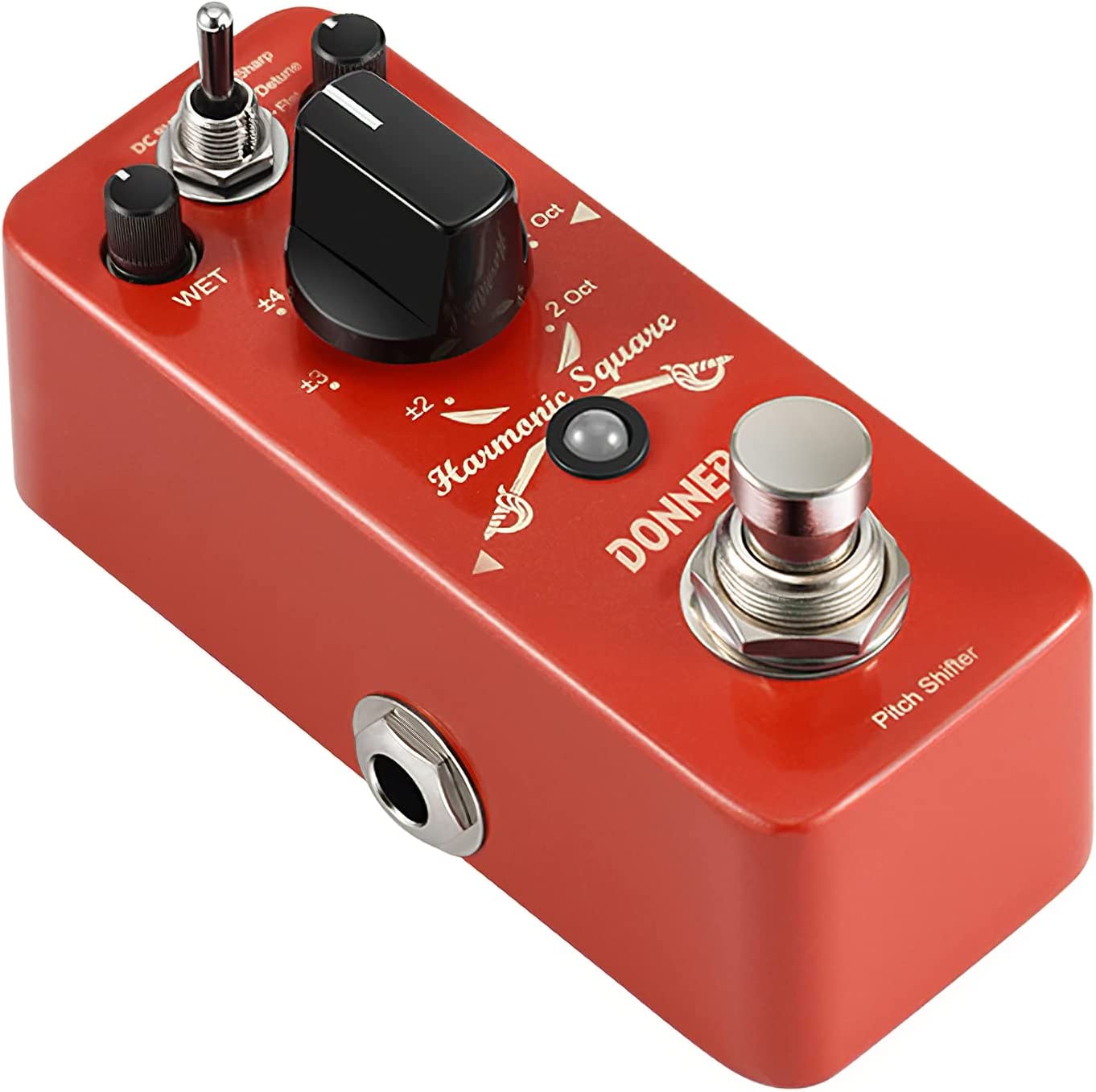
This Donner Octave Pedal termed the Harmonic Square, is a fine piece of equipment that guitarists would find quite handy.
It’s not your usual octave pedal; it presents an impressive seven shift types and three distinct tone modes, including Sharp, Flat, and Detune, each adding its unique effect.
Every feature is carefully built to ensure you have total control over your sound.
This includes two adjustable knobs that modify the harmonic and dry signal levels suitably.
Its design employs digital circuitry, lending the pedal a transparent true bypass tone.
The Harmonic Square prides itself on its durability.
Crafted from high-quality pure aluminum alloy, it’s built to withstand normal use and beyond.
An LED indicator keeps you updated on the pedal’s operational status.
Please note that the pedal only works with a DC 9V Adapter for power supply, which is sold separately.
In terms of size, it’s compact for easy storage and portability, yet robust.
The dimensions are 2.36 x 2.44 x 3.94 inches and weigh a mere 0.27 Kilograms.
This red octave pedal is truly a complementary accessory for guitar enthusiasts.
- My Review
Strumming my guitar through this Donner Octave Pedal, the Harmonic Square surprised and delighted me with its pitch-shifting capabilities.
The seven shift types and three-tone modes took my sound to uncharted territories, delivering octave and detune effects with charming finesse.
The true bypass on this unit is a gem, letting my guitar’s tone shine unequivocally.
Hand on heart, I must admit that adjusting the two knobs, Wet and Dry, required some getting used to.
However, the desired sound level was reached in no time with a little practice, making the pedal a valuable addition to my setup.
What stands out about this pedal is its compact, durable design.
Crafted from aluminum alloy, it boasts solidity – and the LED indicator is a practical addition.
It’s not all perfect, though.
Although a DC 9V Adapter can easily power the Harmonic Square, it’s disappointing that it doesn’t come bundled with the product.
That can be inconvenient if you’re eager to plug and play as soon as you unwrap the pedal.
Regarding the sound, the pedal’s two-octave down setting didn’t differ significantly from the one-octave drop.
Not a deal-breaker, but worth noting.
Nevertheless, it did its job of delivering a robust and warm low-end punch when needed.
Here are the ratings I’ll give to the Donner Octave Guitar Pedal:
Honestly, for its price point, the Donner Harmonic Square is a steal, offering mind-blowing pitch-shifting effects in such an impressive, hard-wearing package.
It’s got its quirks, but its strong build, the variety of tones it offers, and overall functionality make it a worthwhile addition to any pedalboard.
- Pros:
- Great Pitch-shifting capability.
- Durable, compact aluminium alloy design.
- True bypass feature enhances tone.
- Cons:
- No power adapter included.
- Two-octave down signal lacks definition.
- Controls require familiarization.
My final verdict is that the Donner Octave Pedal, Harmonic Square, is a serious contender for anyone looking to add an octave pedal to their setup.
Its compact design, pitch-shifting abilities, and built-to-last casing make it great value for the price.
There are a few downsides, like a missing power adapter and controls, that require a bit of practice, but its benefits outweigh these.
This is an impressive pedal for every guitarist’s collection.
EarthQuaker Devices Data Corrupter Harmonizing Pedal
Wild, analog synthesizer sound with easy setup.
The Data Corrupter is a monophonic analog harmonizing pedal with a crushing square wave fuzz tone that multiplies, divides, and modulates to create a wild three-voice guitar synthesizer. Its PLL modulation adds a unique and unpredictable texture to your sound.
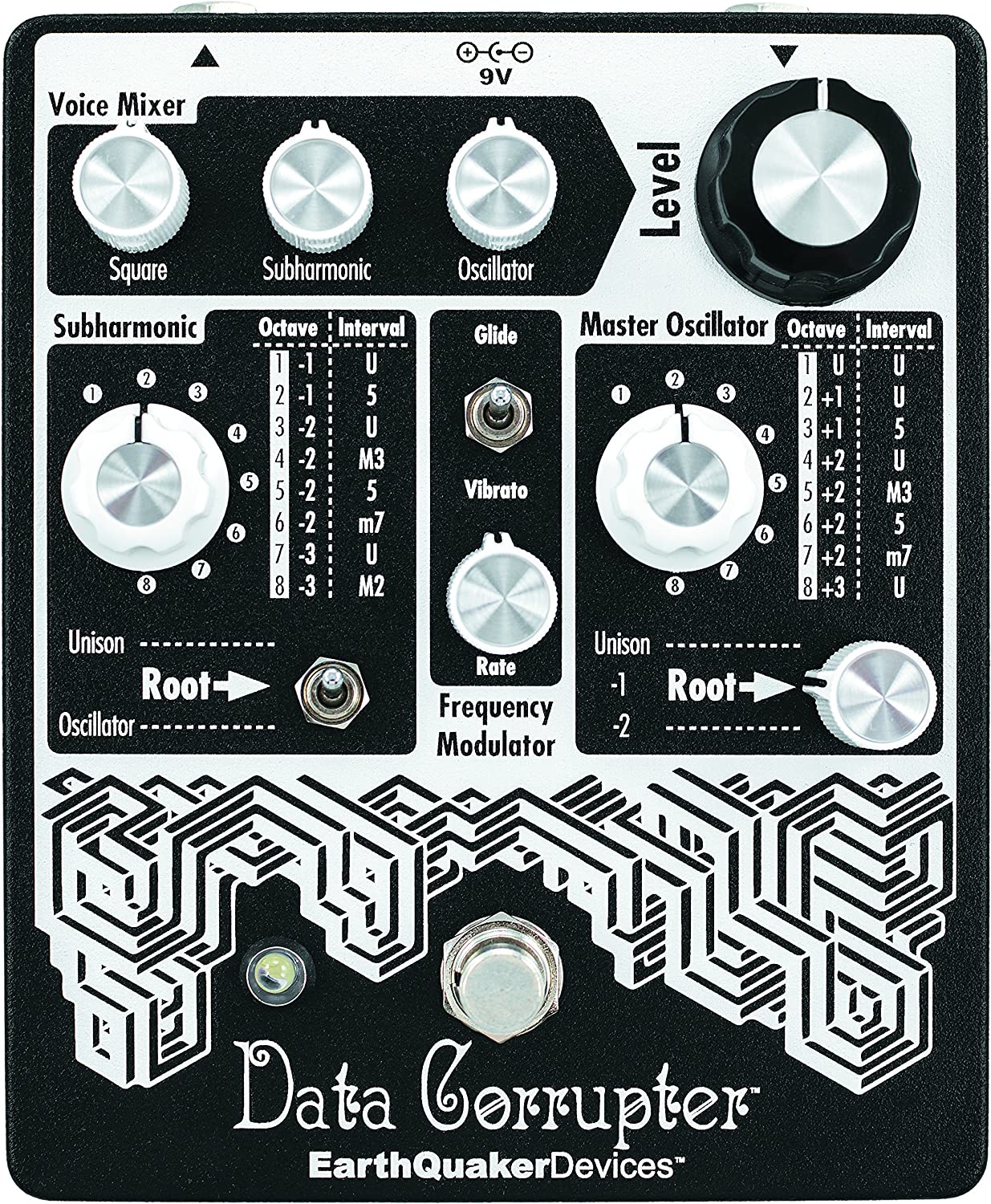
Step into the world of wild and extraordinary soundscapes with the Earthquaker Devices Data Corrupter.
Tailored for the audacious guitar player, this eye-catching black and white stompbox features cutting-edge technology, leading you to sonic terrains previously unexplored.
This harmonizing pedal isn’t your everyday guitar effect.
It amplifies your guitar signal into a robust square wave fuzz tone, then tinkers it further, multiplying, dividing, and modulating to produce a unique yet repeatable, three-voice guitar synthesizer.
It doesn’t stop there; the pedal’s interface is fortified with multiple controls which react and transform your playing in incredible ways.
Despite the surreal tone manipulation, the rugged device remains compact, tipping the scale at a mere 1.46 pounds.
All these features come packed within a small footprint measuring around 6.6 x 5.4 x 3.25 inches, proving there’s more than what meets the eye with this whirlwind of a pedal.
Prepare to unleash the beast and let your creativity ride a wave of sonic euphoria.
- My Review
Diving headfirst into this pedal, the EarthQuaker Devices Data Corrupter, I’ll tell you, was like stepping into a sonic playground.
This isn’t just any stompbox; it’s a game-changer regarding tone manipulation.
I plunged my guitar signal into a robust square wave fuzz tone, after which the pedal transformed it, multiplying, dividing, and modulating it like a mad musical scientist.
It’s a three-voice guitar synthesizer with a wild yet repeatable sound.
Isn’t that something?
Now, to fully grasp this beast, it’s worth remembering that patience pays off.
It took me some time to fully understand its eccentricities and how to bend it to my will.
Once that happens, it’s only a matter of time before you learn to steer this pedal for your musical needs.
It amplifies your creativity, taking your playing into new, unchartered terrains.
A small design drawback is the lack of a dry/wet control.
That could have helped make it slightly less aggressive when needed.
The intense LED light might be too much for some, as it could hinder dial adjustments in certain lighting.
Yet, it’s all about relishing in the quirks of this pedal.
Also, most musical genres may not be suited for this pedal.
But for audacious players exploring crafting experimental or spacey landscapes, the EarthQuaker Devices Data Corrupter is a revelation.
Let’s not forget its sturdy build and top-notch quality – it still looks and functions brilliantly on the pedalboard.
I’ll be real; this pedal isn’t for everyone.
Here are the ratings I’ll give to the EarthQuaker Devices Data Corrupter Harmonizing Pedal:
But if you have a heart for sonic adventures and crave bizarre yet musical sounds, the EarthQuaker Devices Data Corrupter is a fascinating journey.
In the world of guitar effects, this device is not merely a pedal; it’s an experience you won’t forget.
- Pros:
- Produces unique, yet repeatable sounds.
- Stimulates limitless sonic creativity.
- Excellent build quality and design.
- Cons:
- Lack of a dry/wet control.
- Bright LED may hinder dial adjustments.
- Not suitable for all musical genres.
My final verdict is that the EarthQuaker Devices Data Corrupter is a bold, innovative pedal falling slightly to the end of the stompbox spectrum.
It is an exceptional tool for musicians seeking fresh, experimental sounds.
Its fine construction and attention to detail make it stand out, while the absence of a dry/wet control and it’s over-bright LED light might present small hiccups for some.
Notably, its sonic capability may not be optimal for all music genres,, but it’s an opportunity for sound discovery for those who are audacious and open-minded.
It encourages exploration beyond traditional sounds, pushing boundaries in guitar effects.
The Data Corrupter is worth considering if you want to step out of your comfort zone and are eager to experiment with distinct and wild tones.
TC Electronic BRAINWAVES Pitch Shifter Harmonizer Pedal
MASH expression for custom pitch effects and studio-grade pitch algorithms.
BRAINWAVES PITCH SHIFTER offers a wide range of studio-grade pitch-shifting algorithms, 4 octave dual voices, and groundbreaking MASH footswitch technology for expression pedal performance in a pedalboard-friendly size. Create custom pitch settings via the free TonePrint app and enjoy the added benefits of Kill-Dry on/off, True Bypass and Buffered Bypass switch, and Analog-Dry-Through.
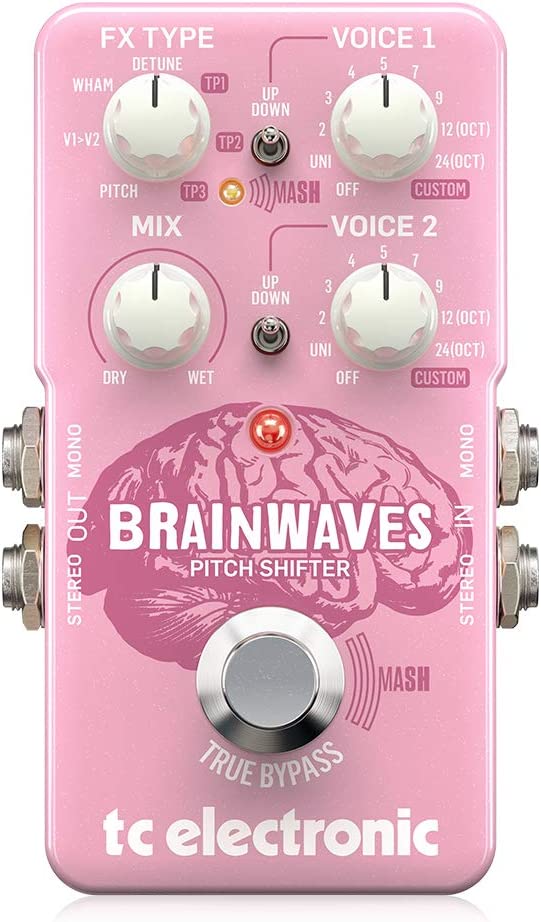
It’s a state-of-the-art device that stands out in its field with innovative pressure-sensitive footswitch capabilities.
It gives you a fully independent dual voice pitch shift, dropping from unison to 2 octaves up or down.
Equipped with a wide selection of studio-grade algorithms, it allows polyphonic pitch shifting, octave up and detunes in whammy-style, and more.
This ingenious tool also features a MASH footswitch that bends the pitch of notes, which you can assign to any of the pedal parameters.
Its compact size takes up minimal space on your pedal board, making it convenient for guitarists.
With the TonePrint tool, you can create unique pitch effects and customize the MASH functionality.
It’s also worth noting that it operates flawlessly with guitar and FX loop signals.
One key characteristic is its ability to maintain the integrity of the analog dry signal path, even when the effect is operational.
It’s an impressive piece of engineering from Denmark.
- My Review
If one thing strikes out about this pedal, it’s the pressure-sensitive footswitch, which is innovative to its core!
This feature alone opens doors to a crazy range of effects by twitching your foot, impressive.
What I relished was the independent dual voice pitch shifting.
We’re talking everything from unison to 2 octaves up or down.
Believe me when I say it feels like magic unfurling under your fingertips: so many options and so much room to take your sound somewhere else entirely.
The myriad studio-grade algorithms add cherries on top.
Polyphonic pitch shifting, detune, and, not to forget, the whammy-style octave up, they’ve crammed it all in.
The MASH footswitch is intriguing, bending the pitch of notes balletically.
I had the liberty to assign this fancy footwork to any pedal parameter, which was quite the experience.
But let me tell you something, the BRAINWAVES PITCH SHIFTER and I had a few disagreements.
It may streamline the workflow owing to its compact size, but the TonePrint software is a tricky devil.
Hours went by fishing around on the platform, trying to customize the MASH functionality.
However, it was smooth sailing once acquainted, creating out-of-the-box pitch effects.
Here are the ratings I’ll give to the TC Electronic BRAINWAVES Pitch Shifter Harmonizer Pedal:
Lastly, I’ll spill some tea on the sound quality, which was nonpareil,, regardless of whether the effect was on or off, the analog dry signal path endured, unwavering in its integrity.
So, despite our spats, I’ve got to attest that the BRAINWAVES PITCH SHIFTER is nothing short of an engineering marvel, straight from the heart of Denmark.
- Pros:
- Innovative pressure-sensitive footswitch.
- Independent dual voice pitch shifting.
- Compact size fits any pedal board.
- Cons:
- Complex TonePrint software interface.
- Time-consuming to customize MASH functionality.
- Limited preset settings.
My final verdict is that the TC Electronic BRAINWAVES PITCH SHIFTER is exceptional music gear.
Despite the initial complexities of the TonePrint software, its versatile features, outstanding performance, and unique pressure-sensitive footswitch make it a great investment for those seeking a creative edge in their sound.
The pedal goes beyond basic functionalities to offer studio-grade pitch shifting, making it a vibrant addition to any pedal board.
Therefore, it receives a solid recommendation for its innovative approach to sound manipulation.
Beetronics Swarm Fuzz Harmonizer Pedal
Unleash wild swarm of sonic bees with Beetronics Swarm Fuzz Harmonizer Pedal.
The Swarm Analog Fuzz Harmonizer creates wild buzzing sounds by multiplying and dividing the frequency of your input signal into nine different harmonies. Control the modulation rate and response with the FLIGHT and STING knobs to create a buzzing, swarming soundscape.
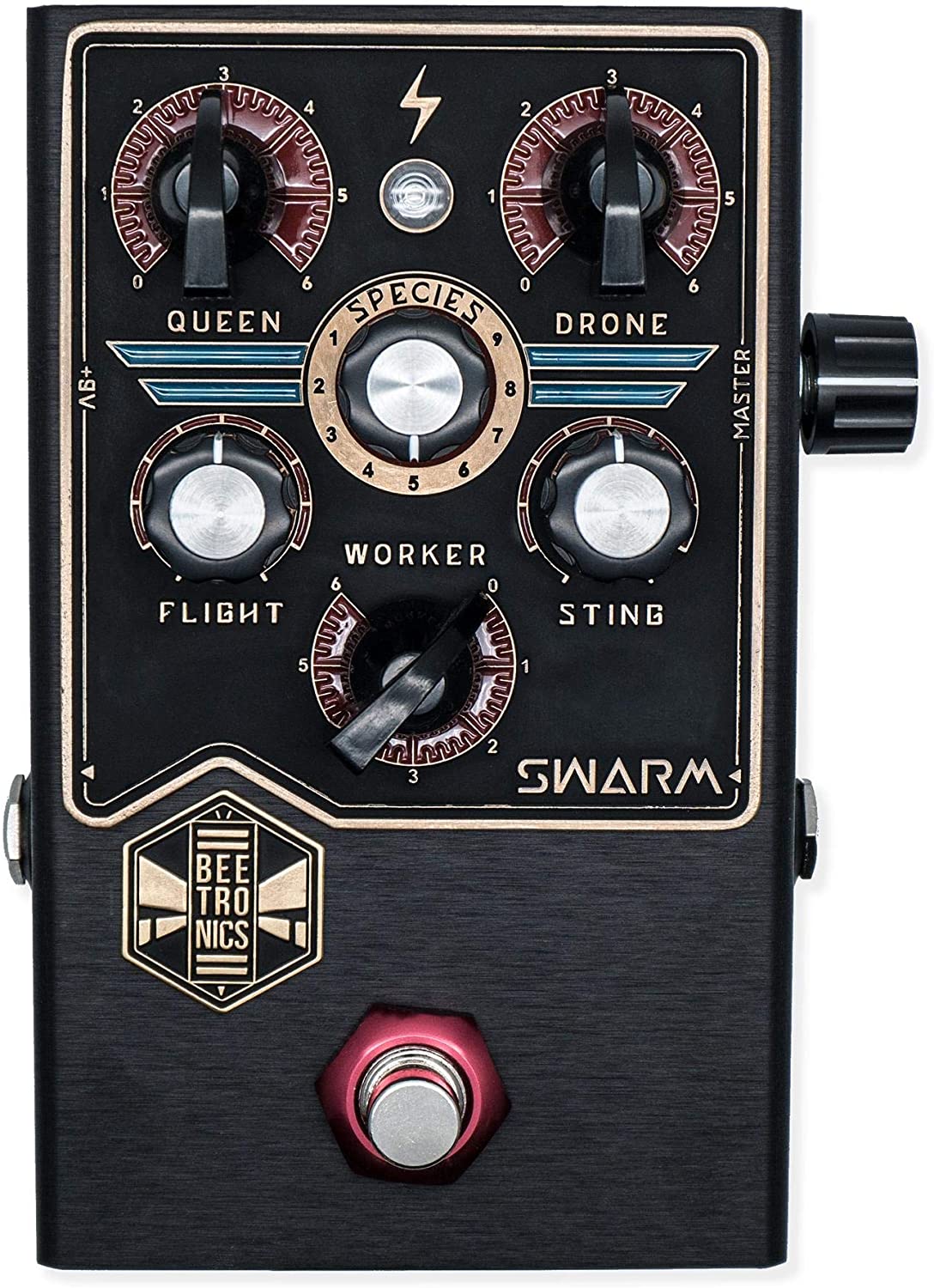
Imagine a pedal that sounds like an army of furious bees on attack – the Beetronics Swarm Fuzz Harmonizer Pedal.
Designed with an analog setup, it shapes your signal into a square wave, creating a unique sound by multiplying and dividing the frequency.
It offers a choice of nine different harmonies spread across two octaves, with modulation options to match your musical mood.
The main controls – WORKER, SPECIES, QUEEN, and DRONE – help you manage the input signal and harmony levels.
You also have FLIGHT and STING for modulation control.
What’s unique about STING is its ability to tweak the speed of harmonies to match your playstyle while FLIGHT adjusts modulation response.
The Swarm is powered by a 9VDC supply, housed in a sleek black enclosure, and is small enough to fit on your pedalboard.
It encourages a play-by-ear approach, inviting you to explore its range to find your perfect tone.
- My Review
What an experience it’s been tinkering with the Beetronics Swarm Fuzz Harmonizer Pedal!
From the outset, you’re met with a sturdy, elegantly designed black enclosure that sits comfortably in a footprint of just under 6 square inches.
An attention grabber, sure, but it’s when you plug in that the Swarm truly comes alive.
At the heart of this pedal, you find a brave fuzz effect, rich and expressive, powered by an innovative circuit that molds your signal into a precise square wave.
But the true magic of the Swarm lies in its unique blend of harmonization and modulation.
With nine harmonies across two octaves, the tonal palette is breathtaking.
I could venture from warm, musically aligned tones to completely wild, unhinged sonic territory with a twist of a knob.
One standout feature was the ‘Species’ knob, a veritable playground of intervals.
A swift turn, and you’re bouncing between different harmonic ratios, each with its unique character.
But the interaction between the ‘Sting’ and ‘Flight’ controls truly resonated.
Sting offered control over the tracking speed of the harmonies, while Flight adjusted the modulation response.
This delicate interplay between controls allowed for an impressive range of tones, from buzzingly chaotic to smoothly hovering.
Now, onto the Swarm’s contentious feature – its pitch tracking.
Undeniably, it lacks the precision of some other pedals.
Those looking for pure, clean octaves might feel a twinge of disappointment.
But that’s missing the point.
The Swarm is not about predictability; it’s about exploring the wild, the weird, and the unexpected.
It’s about the beauty in chaos and the joy of discovery.
The Swarm might come across as a misfit if you’re into conventional sounds and classic tones.
Here are the ratings I’ll give to the Beetronics Swarm Fuzz Harmonizer Pedal:
But for the adventurous sonic explorer, it’s an invitation to a hive of tonal possibilities you never knew existed.
For me, it was a flight worth taking.
- Pros:
- Unique fuzz harmonizer sound.
- Wide range of harmonies and intervals.
- Interactive modulation controls for diverse sounds.
- Cons:
- Poor tracking for pitch effects.
- Limited octave-down and octave-up fuzz tones.
- May not suit all tonal preferences.
While it may have limitations in tracking and limited octave-down and octave-up fuzz tones, it can provide interesting and diverse sounds for those seeking experimentation.
The brand has a good reputation, and the pedal offers decent value for its features.
However, it may not suit all tonal preferences.
Ultimately, it is recommended for musicians looking to explore new sonic territories and embrace its distinct character.
What exactly is a harmonizer pedal?
A harmonizer pedal, essentially an effects pedal, is an tool utilized by musicians, most frequently guitarists, to modify the pitch or tone of their instruments, producing what we often call “harmony.”
This tool ingeniously creates, alters, and enhances the sound to enrich the depth and texture of musical compositions.
It’s akin to adding different spices to soup — amplifying the flavor to achieve a more satisfying result.

The main challenge here is explaining what exactly is a harmonizer pedal in an understandable way, especially for individuals who are not deeply acquainted with music terminologies.
A harmonizer pedal operates by electronically manipulating the pitch of the audio signal it receives, producing a new output that combines the original signal and the adjusted pitch signal, hence creating a ‘harmony.’
This allows musicians to play a note or a chord on their instrument, and the harmonizer pedal will generate another note or chord that harmonizes with the original output.
Imagine it as having an invisible bandmate playing along, but you are in total control.
The concept of a harmonizer’s function may seem simple on the surface, but since music is an art form of boundless creativity, the capacity of a harmonizer pedal spans beyond just duplicating musical parts with altered pitches.
It can create complex harmonies and a variety of interesting and unique soundscapes.
Few of these pedals can produce several voices of harmonization at once, thus enabling a single guitarist to sound like an entire guitar section.
Also, the harmonizer is not confined to only making harmonic intervals in keys, but it can easily follow chord changes as they occur in a song, allowing more complex harmonizations.
One of the critical aspects to understand about harmonizer pedals is that they differ significantly from octave pedals and pitch shifter pedals, even though the boundaries can be a bit blurry at times.
Octave pedals essentially double the signal, either an octave up or down, while a pitch shifter changes the input signal’s pitch.
Although their uses may overlap to some extent, it could be said that harmonizer pedals are more sophisticated, having the proficiency to acknowledge the structure of a chord and establish harmonies accordingly.
A harmonizer pedal’s innate versatility is highlighted by its capacity to create delays, modulate pitch and introduce new elements to a musician’s sound.
Their possibility becomes boundless in the hands of an experimental musician.
Over the past decades, the harmonizer has found its way into countless recordings and performances, loved by musicians for adding layers to the sound and bringing out the creativity in musical performance.
The harmonizer pedal’s utility extends beyond creating harmonics as it plunges into sound design.
Its modifications to the musical notes can add color and texture, creating rich, layered compositions out of simple musical patterns.
Also, the harmonizer plays a crucial role in the live music arena, allowing guitarists to replicate studio effects, and making performances more immersive.
Harmonizer pedals come in wide varieties and are equipped with advanced functionalities like smart harmony controls, expression pedal inputs, and stereo outputs that offer endless possibilities for sound.
Some modern harmonizer pedals also offer MIDI compatibility that opens up an even wider array of performance options letting you control your harmonizer with external devices.
What should you consider when choosing a harmonizer pedal?
Choosing a harmonizer pedal is a crucial decision for guitarists.
This essential tool can elevate your solo performances, add intricate depth to your sound, and fuel your creativity.
However, choosing the perfect one might seem daunting with the many available options. Worry not, we will guide you through all the key considerations.
– Sound Quality
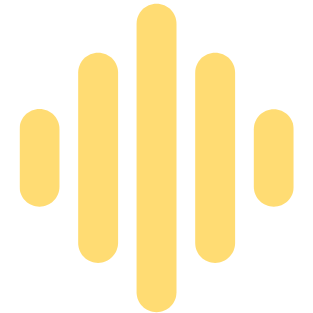
When choosing a harmonizer pedal, sound quality is critical.
After all, the primary function of these pedals is to enhance and modulate your guitar’s audio output.
Thereby, the sound quality revolves around the pedal’s ability to replicate and process your guitar’s tone and its efficiency in projecting enriched harmonies without losing the essence of the original sound.
High-quality harmonizer pedals can deliver organically integrated harmonies into your guitar tone, making it sound as natural as possible.
This includes ensuring that vocal harmonies are similarly adjusted to match the key you are playing.
This parameter will profoundly affect your performance, especially in a live setting.
Choosing a harmonizer pedal with poor sound quality would defeat the purpose of adding this unique equipment to your sound rig.
Therefore, sound quality should always be a top consideration, forming an important basis for your decision.
– Control and features
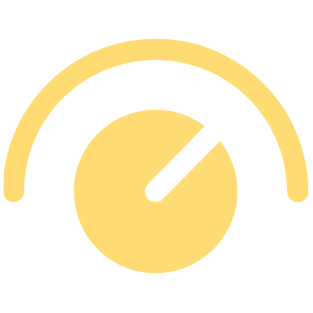
When you consider the controls and features of a harmonizer pedal, you’re examining the device’s command center and what it offers to amplify your music.
These controls and features can distinguish between a rudimentary output and a highly customized, individualistic sound that resonates with your audience.
An effective control interface has marked knobs, switches, or dials that allow you to adjust and fine-tune your sound in real-time easily.
From enhancing your tone’s brightness to controlling the harmony’s strength, these adjustments empower you to define your unique sound.
Key controls generally include parameters like harmony level, type, and key settings.
The harmony level allows you to balance the volume of the harmony with the melody of your main performance.
The type of harmony control helps designate the vocal harmony texture, and key settings let you determine the specific musical key you want the harmony to follow.
These fundamental controls can drastically impact how your music is presented to your audience.

Some advanced harmonizer pedals offer pitch and formant correction features, which can be game changers for live performances.
Imagine accidentally playing a note off-key or singing something that doesn’t quite hit the mark.
With pitch correction, such mishaps can be corrected in real-time, maintaining your performance’s overall integrity and consistency.
Similarly, formant correction can adjust the tone quality of your sound, further refining the final output.
Doubling is another advanced feature that can add depth to your sound by creating a second, slightly different version of your input audio signal.
This can give the impression of multiple guitars playing simultaneously, enriching your solo performances.
Some harmonizer pedals come with built-in electronic tuners for added flexibility and convenience during performances.
This can be a great convenience when you must make quick tuning adjustments between songs.
Similarly, the provision for additional foot switches can allow you to adjust several parameters on the go.
This can help you change the mood of your performance without missing a beat, essentially turning the harmonizer pedal into a multi-dimensional tool part of your performance.
– Analog vs. Digital
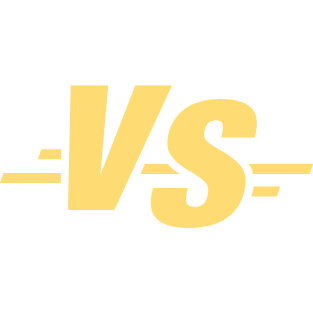
Analog and digital harmonizer pedals are both critical tools in music, each boasting its unique attributes and providing a specific touch to the sonic output.
Analog harmonizer pedals, appreciated for their deep, warm tones, produce captivating sound quality.
This attribute is frequently tied to the charm of vintage and classic sounds, making these pedals a favorite among musicians striving for a distinct, retro audio profile.
This kind of warm, organic sound often fits perfectly into genres such as blues, rock, or jazz, where the texture and tone dynamics play a significant role.
Digital harmonizer pedals, meanwhile, are celebrated for their broad scope and versatility.
They are programmed to reproduce an extensive range of sounds, accommodating the needs of musicians who explore various genres and styles.
Furthermore, they are typically embedded with a multitude of presets, allowing musicians to experiment with various tones and effects and easily switch between them.

The memory storage feature in digital harmonizer pedals is another significant benefit, as it enables musicians to save their preferred configurations for instant recall during performances or recording sessions.
Nevertheless, it’s essential to acknowledge that while digital pedals offer a breadth of capabilities, they may not replicate the richness and warmth associated with analog pedals.
This trade-off is often noticeable in certain genres where a natural, ‘unprocessed’ sound is desired.
Choosing between analog and digital harmonizer pedals thus becomes a matter of balancing one’s sonic preferences with practical needs.
For instance, a musician creating synth-heavy experimental music may lean towards digital flexibility, whereas a blues guitarist might find the warmth of the analog sound more appealing.
Ultimately, it’s about finding the tool that best fits your creative process and aids in achieving the desired artistic expression.
– Build quality and durability

Harmonizer pedals have to endure a lot of wear and tear.
It’s inevitable, especially if you are a gigging musician.
Consequently, build quality and durability should be significant factors when selecting a harmonizer pedal.
While plastic models may be cheaper, they are less likely to withstand a rigorous travel schedule or a tough stage performance.
Metal cases are typically preferred for their durable nature and longevity.
Quality components like switches, knobs, and connectors also play an important part in the pedal’s overall lifespan.
In particular, the switches should provide both robust tactile feedback and also be able to withstand consistent usage, often being stomped on numerous times during a performance.
It’s also critical to note that such switches must maintain consistent electric contact over extensive usage periods to avoid sudden unexpected breakdowns during performances.
Additionally, the knobs should allow for precise tuning and be robust enough to withstand accidental knocks.
They should retain their adjusted positions after the pedal has been transported or stepped on.
Low-quality knobs can lose their settings easily, which can massively impact performance.
As for the connectors, they should not only provide a secure connection for the cables but also be able to resist wear and tear, especially in a gig setting, where plugging and unplugging of cables are a constant.
It’s vital to ensure that connectors don’t become loose over time, as this could result in a weak signal or even a loss of connection.
The design and construction of the pedal also significantly contribute to its overall durability.
A well-constructed harmonizer pedal will have components securely mounted and properly shielded.
The internal circuitry should be properly printed and soldered, reducing the possibility of unnecessary or unexpected breakdowns.
In essence, metal-cased harmonizer pedals with quality components are
– Presets and versatility
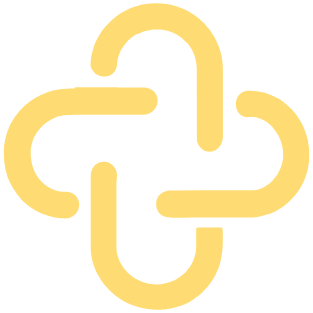
Presets can be incredibly useful on a harmonizer pedal.
They provide a quick way to switch between different settings, ranging from small pitch shifts to harmonies and even modeling different instruments.
A pedal that offers multiple presets can enable you to accommodate a variety of songs and genres.
This versatility allows you to experiment and add more depth to your performances.
It’s especially advantageous if you’re a one-person band or have a diverse setlist.
– Brand reputation

The brand of your harmonizer pedal is more essential than you might initially perceive.
Reputable brands typically provide better build quality, more features, and better customer service.
They have proven track records and are less likely to produce a subpar device.
Well-established companies usually have a heritage of experience and expertise that they incorporate into their products, assuring quality, reliability, and dependable customer support.

Moreover, excellent brands continuously strive to improve and innovate their products to meet or exceed customer satisfaction.
They invest in research and development regularly, ensuring that their products are up-to-date, built using the latest technology, and serve the needs of modern musicians.
Another fact to consider is that top brands usually provide longer warranties on their products, offering free repair services and replacement parts over a specific period.
They take accountability for any potential manufacturing errors or issues, which provides consumers with peace of mind knowing that the company stands behind its product.
Brand reputation also plays a crucial role in the product’s resale value.
Products with a reliable reputation tend to retain their value and are more likely to sell at a reasonable price if the need to sell arises.
Reputation can also influence the availability of the product.
Established brands have wider distribution networks and can be easily found in most online and offline music equipment stores.
They often have faster shipping times and excellent customer service for concerns or inquiries.
– Price and budget

The price of harmonizer pedals can vary significantly based on their features.
Budget pedals may provide basic functionality but lack sound quality, durability, and advanced features.
On the other hand, high-end pedals will offer more robust functionality, better build quality, and superior sound performance.

But not everyone needs the most expensive harmonizer pedal.
Your budget plays a key role here.
Finding a harmonizer pedal that fits your budget is crucial but doesn’t compromise on essential aspects such as sound quality, durability, and necessary features.
– Reviews and recommendations

There’s no better way to evaluate the capabilities of a harmonizer pedal than firsthand testimonials from users.
User reviews provide insights into real-world performance, reliability, and potential issues of the harmonizer pedal you are considering.
They are invaluable resources when weighing potential options.
YouTube is an excellent place to look for reviews, demos and more.

Recommendations from musicians, especially those who play similar genres of music, can also be insightful.
Industry professionals, guitar teachers, and experienced retailers may also offer well-informed suggestions about which harmonizer pedal would suit your specific needs and preferences.
How to properly use a harmonizer pedal?
A harmonizer pedal can transform your music by adding stunning dimensions and richness.
But how do you use it effectively? We’re breaking down the steps to properly use a harmonizer pedal, unleashing your creativity and enhancing your auditory experience.
– Familiarize yourself with the controls and features
A harmonizer pedal is an electronic device used to alter the pitch of a musical instrument.
It allows for real-time pitch shifting and creates harmony in the music by adding one or more pitches to the original tone.
Upon getting your harmonizer pedal, the first step to properly using it is understanding its functions.
Familiarize yourself with the control knobs and the different settings available.
Most harmonizer pedals will have options for pitch, key, mode, type of harmony, and dry/wet mix.
It may or may not have a display screen showing current options.
Pitch controls the pitch of the harmonized note, while the key function sets the song’s key you’re playing in.
The mode function allows you to choose the scale (major or minor), and the type of harmony will enable you to select the specific harmony (third, fifth, octave, etc.).
The dry and wet control balances the original signal and the harmonized one.
– Adjust the parameters to suit your musical goals
After familiarizing yourself with the functions of the harmonizer pedal, you need to adjust the settings according to your musical needs.
For instance, if you’re playing a song in the key of G major and want an added third harmony, you would set the key function to ‘G,’ the mode to ‘major,’ and the harmony to ‘third.’
This way, when you play a G note, the harmonizer pedal will add a B note (a third interval away from G in the key of G major), thus creating harmony.
– Incorporate the harmonizer pedal into your signal chain
The next step is incorporating the harmonizer pedal into your signal chain.
Generally, harmonizer pedals are placed early on in your pedalboard.
This positioning allows the harmonizer pedal to receive the purest signal from your instrument, enabling it to create clear and accurate harmonies accurately.
In other words, it needs to track notes properly, and so giving it a more clear signal is always best.
Connect the input jack of the harmonizer pedal with the output of the previous pedal (or instrument if it’s the first pedal) using a standard instrument cable.
Then, connect the output jack of the harmonizer pedal to your amplifier (or the next pedal) using another standard instrument cable.
I’ll talk about this more indepth later on in this article.
– Set the harmony function
The harmony function allows you to set the type of harmony the pedal creates.
Different harmonizer pedals may offer various harmony options, such as octave up, octave down, third, fifth, etc.
The type of harmony you choose depends on the sound you’re aiming for.
Adding a lower octave can produce a full, rich, resonant sound while adding a higher octave can make the sound brighter and more prominent.
Adding a third or fifth can create beautiful, conventional harmonies that follow the melodies accurately in the key and scale you set.
– Play a few chords:
Now that you’ve set your harmonizer pedal, the next step is to play a few chords or notes and hear how it impacts the sound.
You might need to make subtle adjustments to the settings depending on what you hear.
For example, if the harmonized part is too loud compared to the original signal, you can adjust the dry/wet mix function to balance the two.
Or, if the harmonized notes don’t blend smoothly with the original signal, you might need to correct the key or mode.
– Adjust the mix control:
The mix control, often called ‘dry/wet mix,’ allows you to balance the volume of the original signal (referred to as ‘dry’) with the harmonized one (known as ‘wet’).
With this control, you can create a subtle background harmony, a full-on doubled sound, or anything in between.
If the harmonizer pedal lacks a mix control, the volume control can accomplish this somewhat, but with less precision.
– Practice and refine:
Like any musical instrument or equipment, properly using a harmonizer pedal requires practice, adjustments, and refinements.
As you practice, experiment with different settings, observe the effects, make necessary adjustments, and continuously refine your usage based on your musical goals.
While the harmonizer pedal is a fantastic tool, it won’t instantly make you sound better.
You must develop the ear for harmony, know when to use it, and how to adjust the settings appropriately.
Given the complexity of these pedals, learning to use them efficiently and musically often takes time.
But with patience, practice, and understanding, a harmonizer pedal can enormously enhance your sound, making your music richer, fuller, and more interesting.
How to order pedals on a pedalboard?
There is no one-size-fits-all approach to ordering pedals on a pedalboard, as the optimal arrangement largely depends on the specific sound you’re aiming for.
Usually, though, you will see guitar players mostly agreeing with this order:
Tuner > Filters/Dynamics > Pitch-based Effects > Overdrive/Distortion > Modulation > Time-based Effects > Looper
Aside from that, some general guidelines can help you achieve a balanced and versatile setup.
Let’s talk in detail about the order we just mentioned, but feel free to experiment and adjust to your own preferences:
- Tuner: Place your tuner pedal first to ensure your signal is in tune before passing through the other pedals.
- Filters and dynamics: Wah-wah, envelope filters, compressors, EQs, and noise gates should come next. These pedals affect your sound’s dynamic and tonal aspects, so it’s best to place them early in the chain.
- Pitch-based effects: Octavers, harmonizers, and pitch shifters should come after filters and dynamics since these pedals alter the pitch of your signal and work best with a clean, unprocessed sound.
- Overdrive and distortion: Overdrive, distortion, and fuzz pedals typically come next. They shape your guitar’s core sound, and placing them before most other effects ensures that those effects receive a strong, consistent signal.
- Modulation effects: Chorus, flanger, phaser, and tremolo pedals should be placed after overdrive and distortion effects. We do this to allow these pedals to add depth and movement to your sound without becoming overly distorted or overbearing.
- Time-based effects: Delay and reverb pedals should be placed towards the end of your signal chain. This allows them to create a sense of space and depth around the other effects, simulating the sound of a room or hall.
- Looper: If you use a looper pedal, it should be placed last in the chain. This ensures that you’re looping the entire signal, including all the effects you’ve applied.
Remember, these are just general guidelines and what generally works and sounds good.
The most important thing is to experiment and find the arrangement that best suits your personal sound and style.
For example, here’s one pedalboard signal chain that I always use:
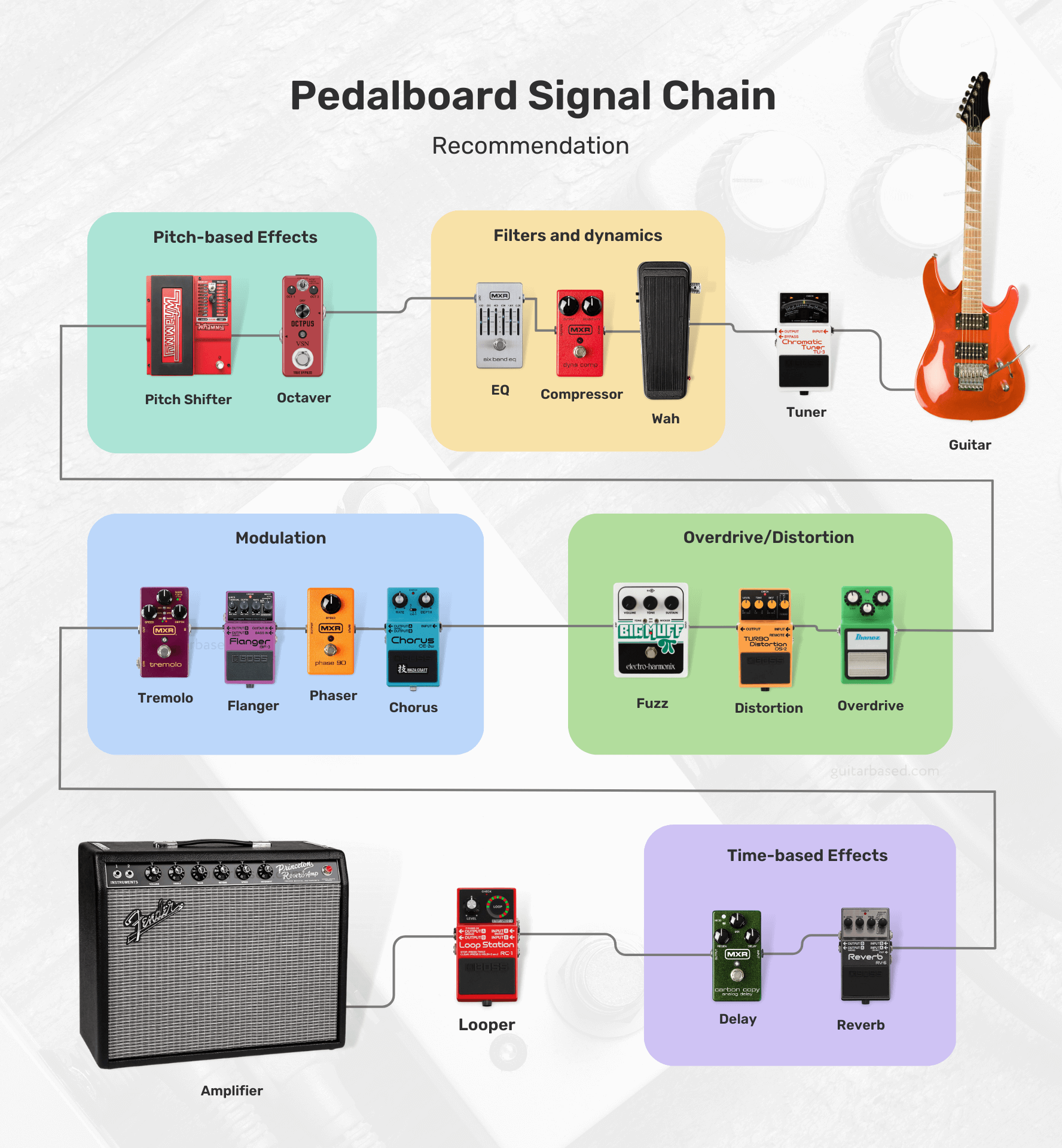
Feel free to swap the order of pedals, try different combinations, and test out unconventional setups until you find the one that works best for you.
For those interested, I’ll leave you with most of the possibilities that you’ll encounter and how to order them.
- Tuner
- Filters/Dynamics:
- Volume
- Wah
- Auto-Wah
- Compressor
- Noise Gate
- EQ (Equalizer)
- Pitch-based Effects:
- Octaver
- Harmonizer
- Pitch Shifter
- Overdrive/Distortion/Fuzz:
- Boost
- Overdrive
- Distortion
- Fuzz
- Modulation:
- Chorus
- Phaser
- Flanger
- Univibe
- Vibrato
- Tremolo
- Time-based Effects:
- Delay
- Echo
- Reverb
- Synth/Bitcrusher:
- Synth
- Bitcrusher
- Acoustic Simulator
- Multi-Effects
- Utility:
- Buffer
- A/B/Y Switcher
- MIDI Controllers
- Looper
Boutique vs. Mass-Produced pedals
Boutique pedals are generally built with higher-quality components and craftsmanship, resulting in better durability and longevity.
These pedals often feature unique and innovative designs, providing a wider range of tones and effects that may not be available in mass-produced options.
Here are a few examples of boutique pedals:

All the manufacturers also tend to have a more personal approach, with better customer service and the ability to customize pedals according to the user’s preferences.
However, boutique pedals are usually more expensive due to the smaller scale of production and the use of premium components.
Mass-produced pedals, on the other hand, are more affordable due to their larger scale of production and the use of cost-effective components.
These pedals are widely available and offer a range of popular effects, making them accessible to a larger audience.
Here are a few examples of mass-produced pedals:

The quality control for mass-produced pedals can vary depending on the brand and model, but many are reliable and offer good value for the money.
As for one of the downsides, you’ll find that mass-produced pedals may not have the same level of uniqueness or innovation as boutique options.
On the other hand, they may not provide the same level of customer service or customization options.
The choice between boutique and mass-produced pedals depends on your personal preferences, budget, and desired sound.
If you’re looking for unique tones, higher-quality components, and a more personal experience, boutique pedals may be the way to go.
But I would say, for those who are on a budget and need access to popular effects, mass-produced pedals might be a better fit.
It’s worth trying out both types to see which best suits your needs and playing style.
How much should you spend on a guitar pedal?
If I were in your position, I would first determine my budget and specific needs before deciding how much to spend on a guitar pedal.
For beginners, it might be more reasonable to start with affordable, mass-produced pedals to explore different effects without spending too much.
Guitar pedals can range in price from around $30 to over $400, depending on the brand, quality, and complexity of the effect.
As your skills and understanding of your preferred tone develop, you can gradually upgrade to higher-quality or boutique pedals.
One thing I would do is consider which effects are essential to your playing style and prioritize purchasing those first.
Allocating a larger portion of your budget to the most important pedals might be a wise choice, especially if you only need a few basic effects.
However, if you require a wide array of effects, you may want to consider more budget-friendly options or multi-effects units.
Keep in mind that higher-priced pedals often come with better build quality, unique features, and improved sound quality.
But I would also say that price is not always directly correlated with quality or suitability for your needs.
Sometimes, a more affordable pedal can deliver the exact sound you’re looking for, while a higher-priced option might not meet your expectations and are only expensive because of the brand reputation.
Can you use a guitar pedal with a bass guitar?
You can certainly use a guitar pedal with a bass guitar.
But it’s crucial to be aware that some guitar pedals may not be specifically designed to accommodate the frequency range of a bass guitar.
This could result in a less-than-ideal performance or an altered tone that might not be what you were expecting.
If you’re feeling adventurous and eager to experiment with your sound, don’t hesitate to connect your guitar pedals to your bass guitar.
This can be a fun way to explore different sonic possibilities, and you might even stumble upon some unique tones that complement your playing style perfectly.
Using a guitar pedal with a bass guitar may not always produce the desired results.
In some cases, the low-end frequencies might be lost, or the effect could sound too harsh or muddy.
To avoid these issues, you could consider looking into pedals that are specifically designed for bass guitars.
These pedals are engineered with the bass frequency range in mind, ensuring that your low-end remains intact and the effect sounds as intended.
In addition to bass-specific pedals, there are also multi-effects processors and pedals that cater to both guitar and bass players, offering a wide range of effects and tonal options.
These versatile units can be a great solution if you play both instruments and want a single device to cover your needs.
How to properly power your pedals?
When it comes to powering your pedals, you want to make sure you’re doing it right to avoid any noise issues or potential damage.
First, check each pedal’s power requirements, which you can usually find in the manual or on the pedal itself.
You’ll want to pay attention to the voltage (usually 9V, 12V, or 18V) and current (measured in milliamps or mA).
Now, you’ve got a few options for powering your pedals.
You can use individual power supplies or batteries for each pedal, but that can get messy and inconvenient.
I’d recommend going for a pedal power supply or an isolated power brick.

For example here are a few ones I recommend:
- Voodoo Lab Pedal Power 2 Plus Isolated Power Supply (My favorite)
- Rowin PW-1 Guitar Pedal Power Supply (Cheapest)
These babies can power multiple pedals at once, and the isolated outputs help prevent noise and ground loop issues.
Just make sure the power supply you choose can handle the voltage and current requirements of all your pedals.
When you’re connecting everything, use good quality power cables and keep them neat and tidy to avoid a tangled mess.
You might even want to use cable ties or cable organizers to keep everything in order.
In love with guitars, and gear; expert in all things music! Been writing about guitars for about 5 years and counting. Born in the ’90s. Alma Mater: University of Havana. Always curious, trying to understand the world. #TeamFender

